3.1 Multimedia Art Workshop
3.1 Multimedia art 2nd pilot test
Introduction
We have done a home visit and first pilot test in Naveed and Uzma home. Thought these two research, we understand that the multimedia art workshop has the potential to further develop. Before the workshop is truly executed, the second pilot test held on 27th October of 2019 in Artsteller studio. The multimedia art workshop is highly technical and highly refugee-oriented. During the skill jamming, refugees can share their skills and culture with locals. We would like to test the feasibility of holding the workshop with is positioning.
Objectives
Our pilot test successfully matches the participants for this type of activity i.e. Academy subject. It can facilitate the practice of empathy so that parties involved understand each others’ sense of belonging to the city, especially through the story sharing by the refugees Uzma and Naveed. Through the appreciation of the client’s artistic skills and spirit, knowledge serves as the medium instead of the end of sharing. We are not aiming how beautiful the participants drew the Mughal art, but focus on how they learn, try and devote to the whole pilot test.
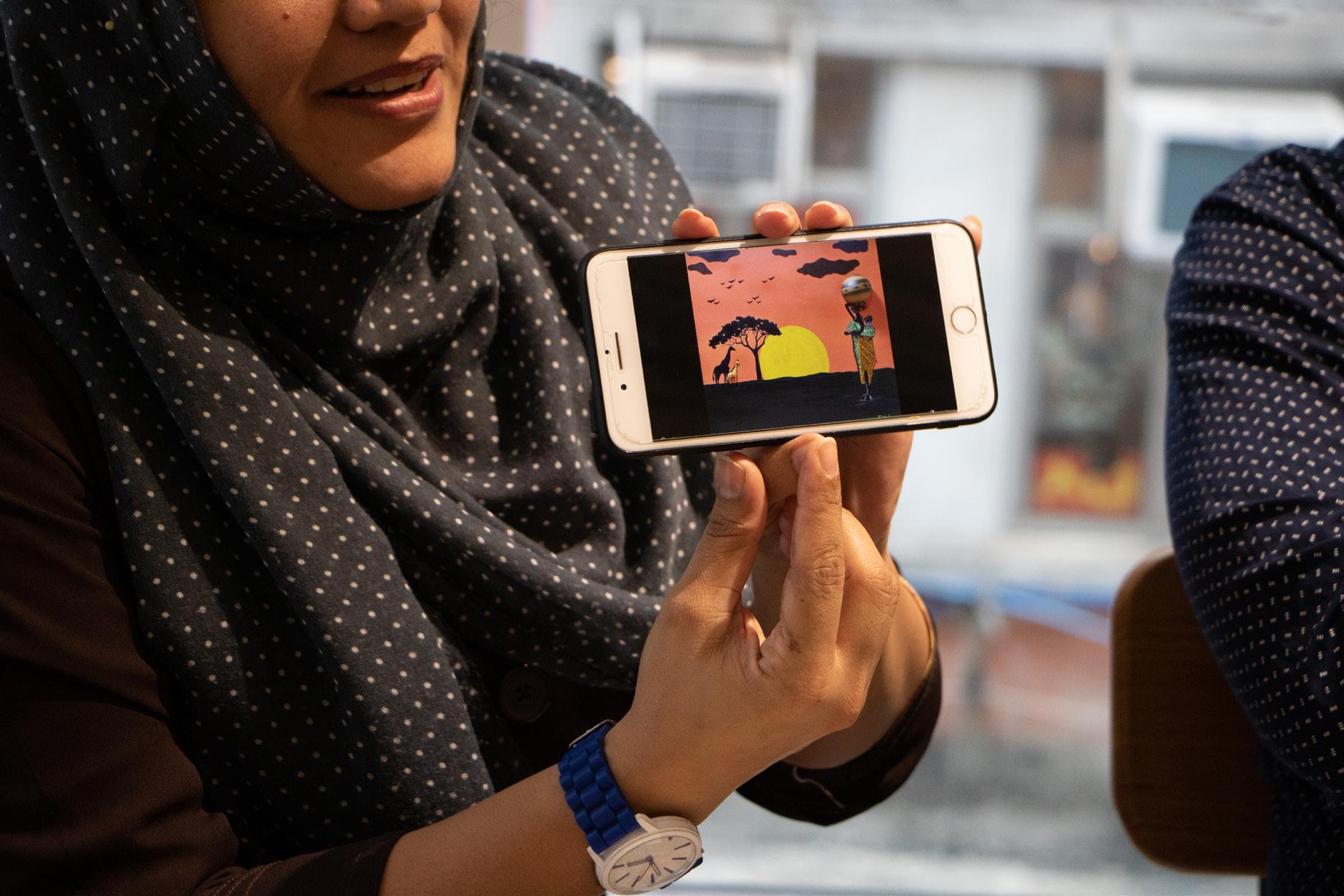
Preparation
There are quite a lot of things that we need to prepare for this multimedia art pilot test. Apart from preparing the painting tools, we need to find and book the venue and communicate with the venue owner. We also need to contact with other stakeholders, like refugees and our participants. For planning our pilot test, we also need to discuss our expected flow of the pilot test.
Material preparation
In terms of the material preparation part, there are a lot of art materials that we need to prepare. Our pilot test workshop is about painting Mughal Art on the fabric and we need to prepare the special fabric color. We expected the participants can bring their own wearable objects. The 100% cotton wearable object need to have A5-A4 area to draw the patterns, an occasion they expect to be using the decorated object. As the participants are going to draw and paint the Mughal Art, which are small and detailed patterns, the soft pointed painting brushes(no.2 and 4) are necessary. Plastic paintings palettes and plastic mugs, for washing the colors on the brush, are also needed. A4/ A5 cardboard is essential as it acts as a barrier between the front and back layers of the fabric. Putting a cardboard under the fabric can make the fabric more flat and easier to paint on it.
dots. 101
100
3.1 Multimedia Art Workshop
03 Connection
Location
In term of finding the venue for the pilot test, we need to choose the best venue for our event that fits with our set criteria and budget. We have found Artstellar Studio (不日上畫) to hold our pilot test. There are sufficient drawing tools to support our pilot test and this helps to lower our material preparation cost. In terms of contacting with the venue owner, we need to find a suitable time which is fit for all of us. The venue we booked is an art studio, so different clients will go there and have painting lessons. We have booked the studio one week before our pilot test.

As the test held on Saturday, the venue owner needs to arrange the Saturday painting class to other days. Besides, we need to tell the venue owner what types of activities we are going to do. It is because we may make her place dirty and also need to follow the art studio regulations. And we would also check is the drawing tools really suitable for our activities and is the amount of them is sufficient for us.
Although our pilot test is held from 3:00pm to 7:00pm, we have booked the art studio from 2:00 pm- 8:00 pm. We will go there one hour early for material preparation and leave one hour later for overtime and tidying up the place. After the test, we have also followed up with the venue owner for comments. Besides, we have to remind the venue owner that refugees’ faces should not be photographed or uploaded to any social media before the pilot test held.
Contact Point Contacting with refugees
In terms of contacting refugees, it is important to build trust with our clients before everything, be it workshop collaboration, interviews, or other forms of contact. As designers, we may see lots of “potentials” in clients’ development and assets. Yet, instead of fulfilling our own motives or wild imagination, we always bear in mind the “problem” and clients' needs we are tackling, which should be the true incentive for further action. Therefore, being an active listener with an open mind enables the natural flow of conversation that may lead to further connection, is the prerequisite of constructing an effective and enjoyable relationship. One area of improvement is to define our own roles and project objectives as early as possible after the initial stage of contact with clients so that designers are not treated as “just another student trying to fulfill homework requirements”. This can lead to undesirable outcomes such as clients overlooking or underestimating the significance of activity achievable, thus mismatched expectations or even lose of interests in the long run. In sum, to avoid offensive scenarios and cultivate creativity together, being honest and observant are the two essential qualities for meaningful communication with refugees.
Contacting with participants
In term of contacting participants, we need to have expectation management to our participants and communicating with participants. There are 7 local participants joining our pilot test. In the expectation management part, we will have the metal preparation for participants. We expect them not to draw very detailed pattern as we only hope they enjoy the process of drawing and for fun. We expect them to bring their own garment which have A5-A4 size to draw.
dots. 102 103
03 Connection
3.1 Multimedia Art Workshop
They feel free to ask questions in the activity. For communicating with participants part, we have opened a WhatsApp group and remind them the important things there. The message is to remind them about what they need to bring, where is the pilot test hold, the introduction of the pilot test, etc. Besides, we remind participants that they need to open to ethnic minorities and refugee community, communicate in English, are curious and having interests in artistic and group communication. Our participants don’t need to be professionally trained in Art & Design field as we want to focus on the storytelling part and the Mughal art learning part. Therefore, how beautiful they painted is not the key point of the pilot test. Besides, we have to remind participants that refugees’ faces should not be photographed or uploaded to any social media before the pilot test held.
Expected pilot test flow
In term of our expected pilot test flow, we expected that the activity not only about drawing, but also about have storytelling part. Through facilitated discussion and Mughal art pattern making sessions, participants are guided to exchange ideas with art advisor, then visualize a message to Hong Kong on a wearable object. Our 2nd pilot test is being held on Oct 26 Saturday 3:00pm7:00pm (3.5 hours + 30-60 mins evaluation session). The following below is about our expected flow of the pilot test.
2:00pm- 3:00pm Round table Set-up
3:00pm- 3:10pm Buffer time/Moderators doing activity intro, announcing ground rules
3:10pm- 3:45pm Discussion:
Self-introduction with Wearable: Why do you bring this wearable?
Places: Which is your favourite/ most visited/ disliked place in Hong Kong?
Refugees as fighters: Hong Kong Protestors, are we comrades? (after distributing news clip, open-floor discussion on the issue)
3:45pm- 4:00pm Buffer time/ Uzma and Naveed sharing more about their life, background, and stories
4:00pm- 4:40pm Art sharing: Naveed’s selected works display and sharing.
4:40pm- 4:50pm Participants consolidate and draft their main idea based on the following
Topic 1/ A message to Hong Kong?

Topic 2/ Conclusion & insight about today's activity/ clients experience
Topic 3/ Reimagining _________ in Mughal Art
5:00pm- 6:30pm Participants finish their visual message with paints provided, while receiving drawing teachings from Naveed about chosen elementary pattern
6:30pm- 7:00pm Group evaluation ( to clients & to Participants)
7:00pm- 7:30pm Individual feedback
dots. 104 105
03
Connection
3.1 Multimedia Art Workshop
Stakeholder Aplication System
To organize a successful and sustainable workshop, stakeholder participation is really important. The five stakeholders of this pilot test include participants, venue owner, art advisor, storyteller, and organizer moderator.
Participants
For the second pilot test, we invite six participants to join because the workshop only affords a few people to join. The venue is not big which can only afford around ten people to sit around the table.
Besides, we have asked our art advisor Naveed that he cannot teach too many students so we predict 5 to 6 participants in the available number. For the requirement of the participants, we prefer they are not working in the art or design industry.
And they don’t have professional art painting skills but they are interested in learning Mughal Art. They should be open-minded to accepted new things while the cultural exchange session. Also, they have to be Hong Kong residents so that they understand the situation in Hong Kong. They are able to communicate in Cantonese and English with refugees and locals. Therefore, the participant can listen clearly to refugees’ stories and teaching guidance. In the two way communication, the participant can also introduce Cantonese to the refugees.
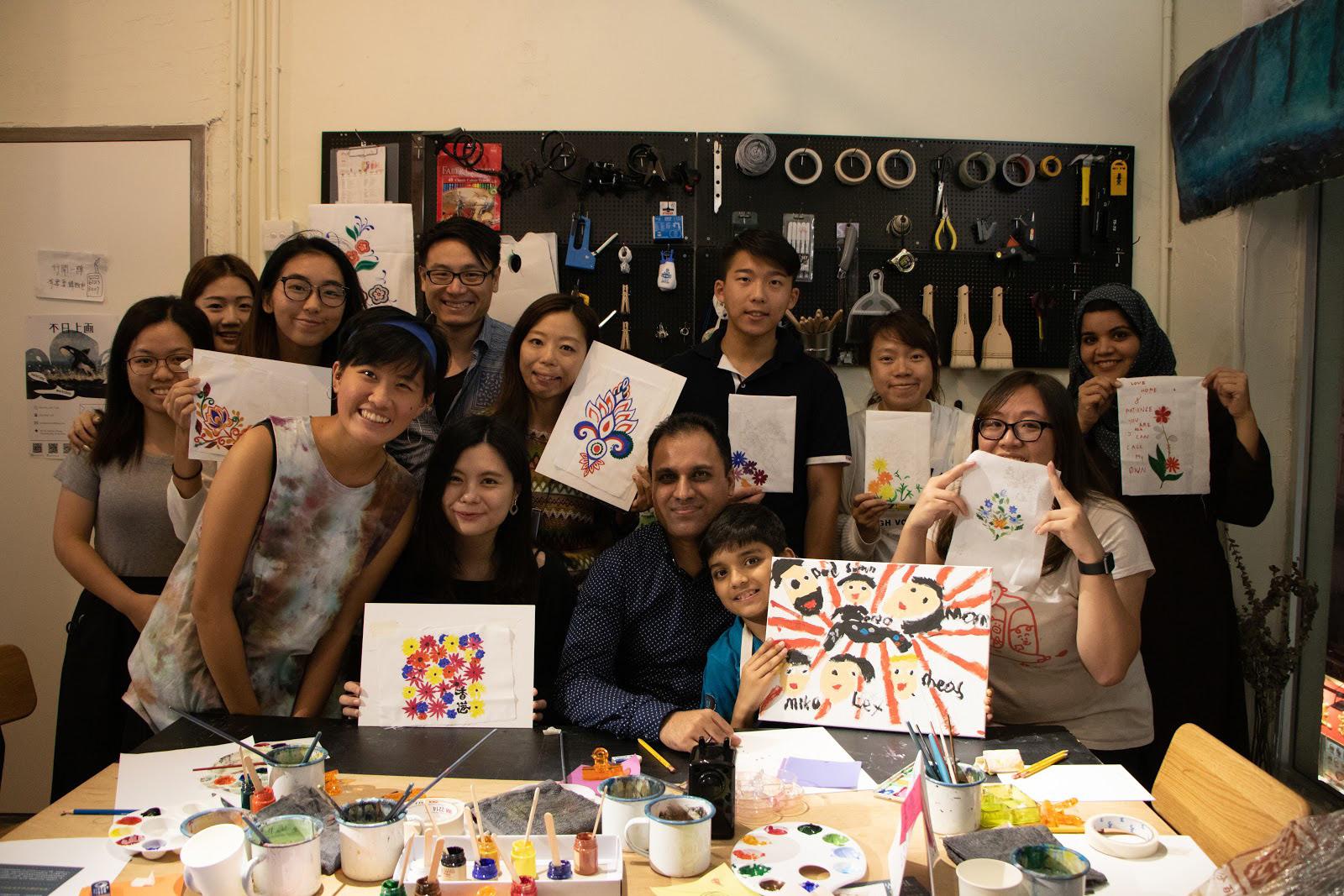
All of them are invited by our tutor Kam Fai, who is his former social design student, friends, and facebook fans. Some of them are working as a social worker, BAFS teacher. One participant is a cultural studies student.
The role of the participants in the pilot test is to build up a small local community. As refugees have different cultural backgrounds with locals, it is difficult to join the HK community. This platform allows refugees easier to communicate with locals and find their identity.
Venue owner
Venue owner Neol also participates in the pilot test. Her role is to provide a venue as a safe platform for refugees and locals to communicate and learn peacefully. With no worries in strangers’ unexpected involvement, the pilot test can run in a private place smoothly. Venue owner also has the role of a resource provider. She can prepare resources like water, towel and cup because this resource is related to the venue.
dots. 106 107
03 Connection
3.1 Multimedia Art Workshop
Art advisor
Art advisor is the refugee Naveed, he is also a member of Christian Action. In the pilot test, his role is to share his Mughal Art painting skills and guiding the participant. Using the art skill as a media, to share Pakistan culture to local.
Storyteller
Naveed’s wife is participating as a storyteller in the pilot test. Storyteller’s job is to share her stories and the reason of becoming a refugee. Her role is to increase local recognition in refugee. Since Uzma is the first-party to share stories, locals can empathetic listening and feeling. The local can have a closer and deeper look at the refugee issue.
Organizer and moderator
Organizer and moderator jobs are to organize and host the pilot test. PolyU designers are involved in the pilot test and have different jobs included host, facilitator, observer, and photographer. There are four PolyU designers doing these jobs. During the activity, the host has to lead the whole workshop and manage the time. The facilitator and helper have to help safeguarding group dynamics.
The observer will do the note-jotting, recording key points, quotes, ideas as discussion pick-up points. For the photographer, she will photographic all the artworks’ outcomes and processes for documentation. It is important to avoid taking pictures of clients.
3.1 Multimedia Art Workshop
Pilot test flow in reality
14:00 - 16:14
Preparation
PolyU designers arrived at the Artstellar studio one hour before the pilot test start. After we arrived at the studio, we start to observe the venue and discuss the arrangement. Besides, we talked with the venue owner Noel, about our schedule, backgrounds, and ourselves introduction. At the same time, we do WhatsApp coordination with the participant. While we are waiting for the participant, we answer their questions in WhatsApp. We prepared some snacks and fruit for the participant so they can enjoy the sharing time.
Some of them prepare the material of the pilot test, including cutting the fabric, preparing the paints, filling the water into a cup and distribute all the material to the participant. We were preparing the material until the ice-break session is finished.
15:15 - 16:00
Ice-break
The pilot test official starts at 15:15. Unexpectedly, one of the participants brings a friend to join the workshop so there are seven participants in total. As all of them are first met, the host did some warm-up. The host starts a small tour to introduce the studio to the participant. Later, the host organizes an ice-break game by jot down the first impression/questions on paper. By playing a name remembering game, the participant did a self introduction one by one. When they introduce their name, they have to repeat the previous participant’s name. In the end, the final participant has to remember all the participant’s names.
16:00 - 18:00
Story Sharing
Start with the news clip discussion, the host tried to build up a message to the audience. To point out that the presence of a refugee is already against the world. This session only conducted for 5 to 8 minutes, because the participant is not interested in reading the news clip.
dots. 108 109
03 Connection
In real-time flow, sessions are overlapping with each other.
19:00 - 20:00
Wrap up
When most of the participants finished their pattern making, we start to wrap up and clean up with Noel. We found that we have perpared too many paints for the pilot test. We bought 4 boxes but we only open 2 boxes of paints and did not use up.
19:00 - 20:00
Group evaluation
While some of us were wrapping, our host had a group evaluation with participants. She asked two questions:
1. A message to Uzma & Naveed: What’s new, gain and loss?
2. A message to organizer: What message have you received from us? Do you understand the activities? Intention, content, and positioning? And the participant wrote the comments on color papers. We and Naveed collected color papers.
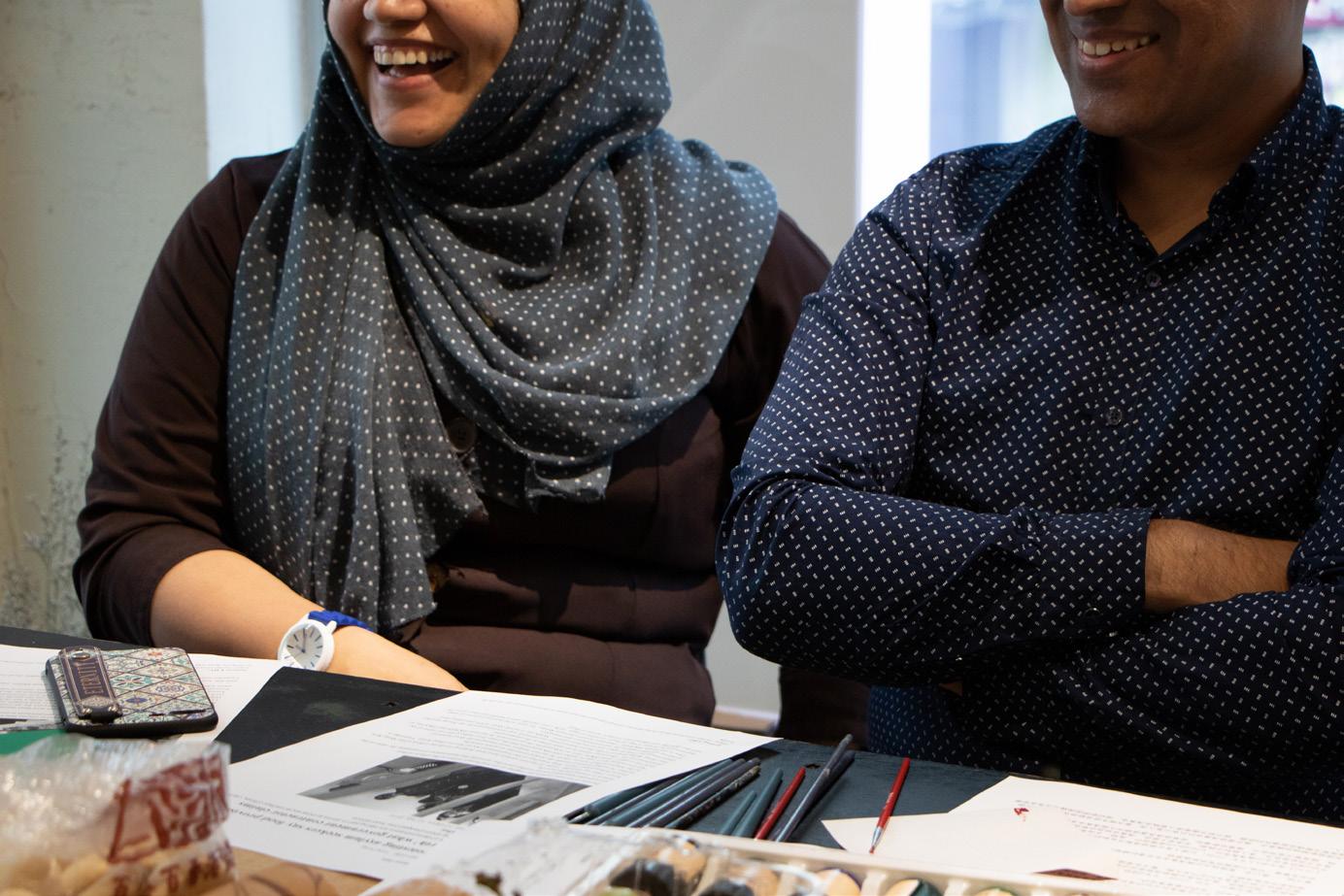
17:00 - 20:00~22:00
Mughal Art pattern making


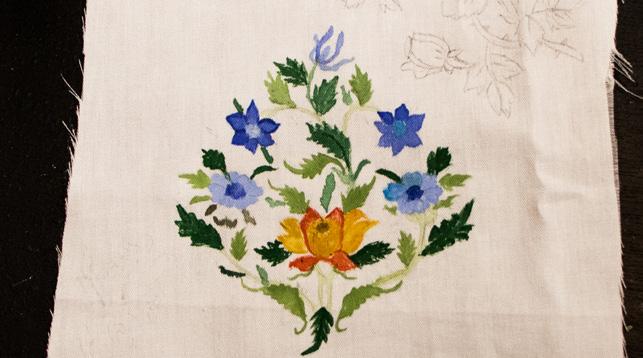
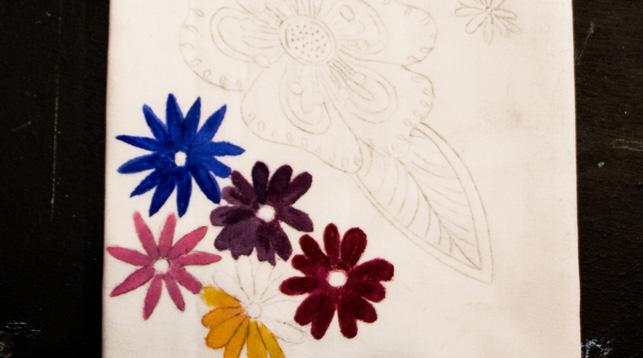
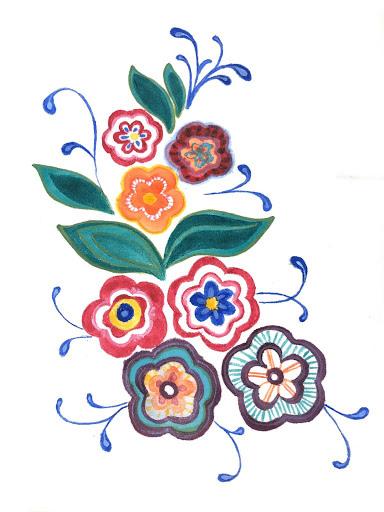
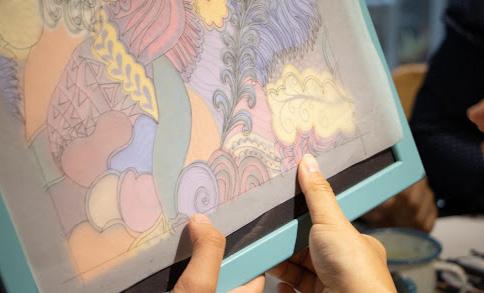
Naveed demonstrates the fabric painting practice to the participant. He had prepared some tracing paper with a pencil-drawn pattern on it. He distributed the tracing paper to all participants and they traced the pattern on their fabric. Later, he taught them how to mix the colors, holding the painting brushes and drawn on the fabric. One of the participants wanted to finish the whole drawing although the pilot test was finished. Luckily, the studio did not close immediately so he can continue until ten o’clock.
The participants' painting

dots. 110 111
03 Connection
3.1 Multimedia Art Workshop
While some of us are wrapping, our host had a group evaluation with participants, focusing on asking the participants comments. The host has asked them two questions.
A message to Uzma & Naveed: What’s new, gain and loss?
From Howard to Naveed: You are born to create. You have a higher valued of purpose in your life. I can see your creation/ textile designer being life, hope & courage to those who see/ wear your arts! Love your smile.
From Howard to Uzma: You are a great speaker, teacher, and messenger. You are a true leader and a great mother.
From Claudia to Uzma and Naveed: I am learnt about the situation of Asylum seekers in Hong Kong, also situation specifically in Pakistan. I have gained new friends and a nice experience of painting. I will sew the paintings on a tote bag.
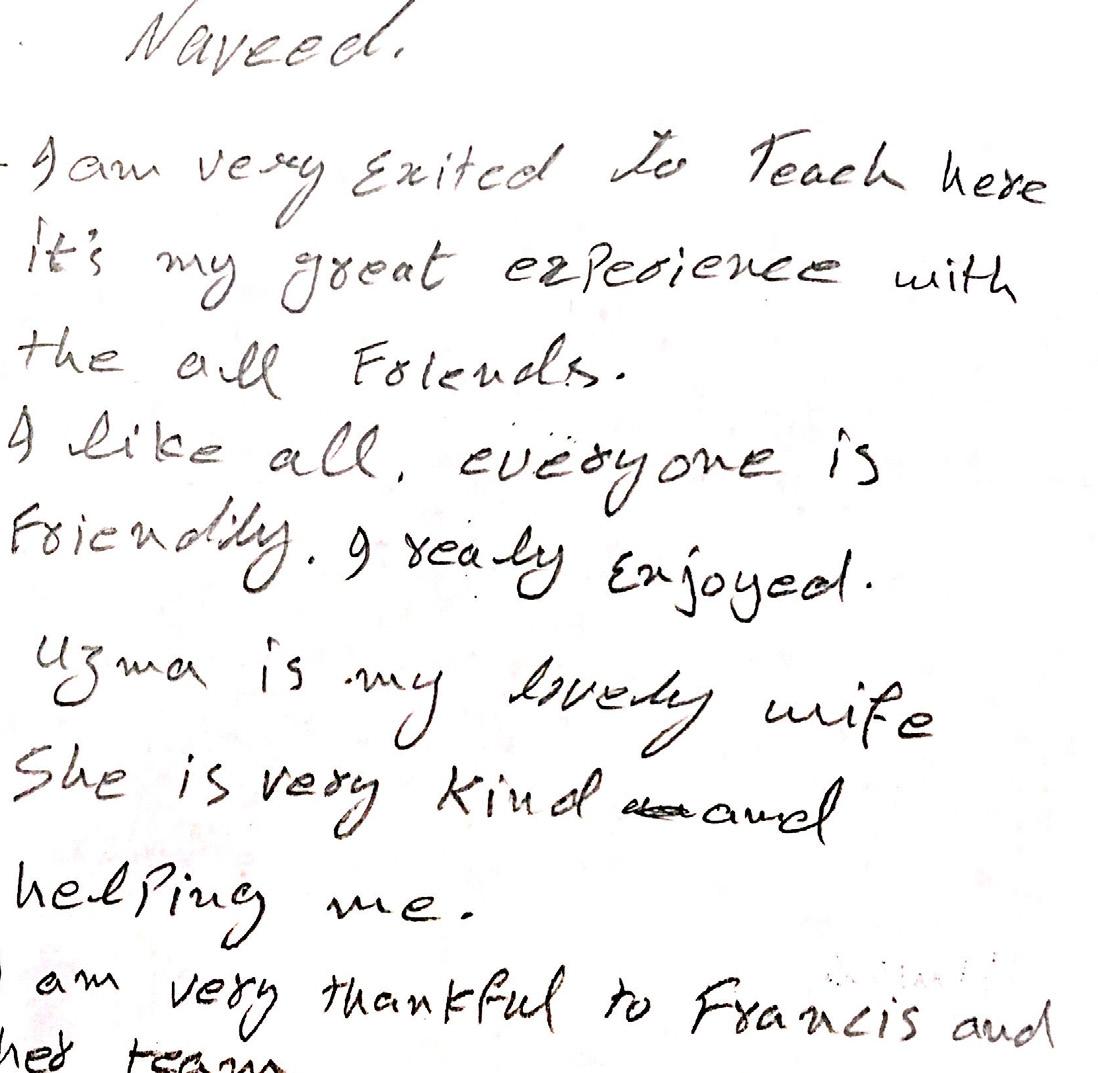
Participant Feedbacks
A message to organizers: What message have you received from us? Do you understand the activities? Intention, content, and positioning?
From Naveed to organizers
I am very excited to teach here, it’s my great experience with all the friends. Everyone is very friendly.
From Uzma to organizers
The workshop had been a way to meet people and they were all so good and friendly. You guys organised it so well. Keep doing this work and letting people know about refugees and Asylum seekers.
From Howard to organizers: You guys can try to ask the participants how they use these paintings linked to Hong Kong refugee problem at the end of the pilot test. Great rundown keeping and arrangement.
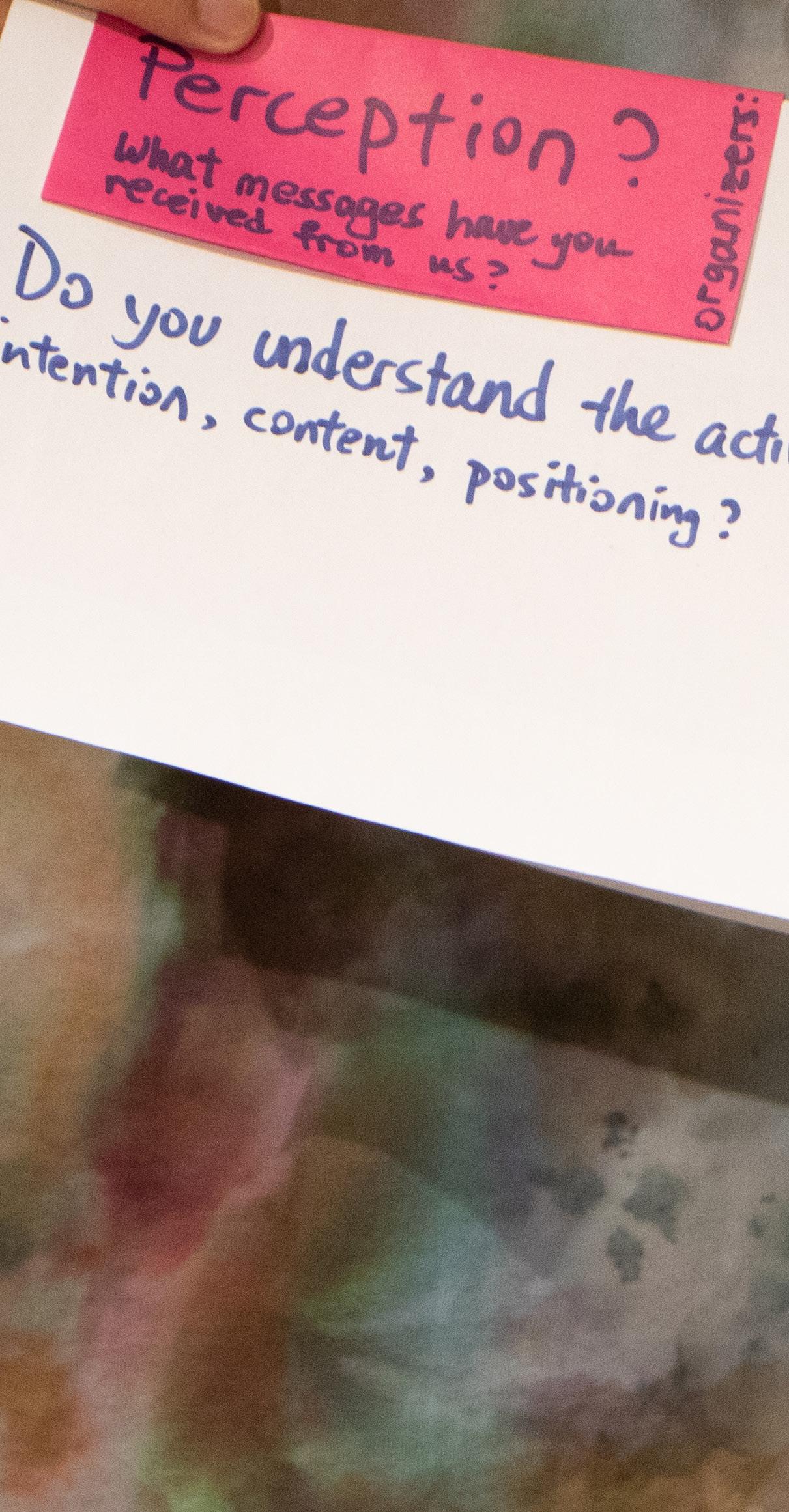
From Jessica (BAFS teacher) to organizers: Through this activity, I can know the true story of refugees living in hong kong. It is worth to let more people know is art a good method to lower barrier between locals and refugees. I suggest that there are more time to listen to their part of the story in HK.
From Claudia to organizers: Notice of what to prepare (fabric) should be announced one-week earlier. It might be easier if you prepare all material in advance.
From Celeste to organizers:
I like the vibes that we all could just chat and draw at the same time. Yet I suggested the size of the artwork may be a bit smaller since the design is kinda complicated, feel kinda rushed and pressure for me to finish the work.
dots. 112 113
03 Connection
3.1 Multimedia Art Workshop
Findings:
Improvements of the pilot test
Fabric preparation
For the fabric preparation, we expected that participants bring their own wearable objects to the pilot test. However, they bought a cotton cloth and shared in reality. The next time, it is better for us to buy the cotton cloth and separate them into A4/ A5 size before the pilot test. It is because most of the participants don’t have unwanted wearable objects in their homes.
Contract with the venue owner
As the process of planning a pilot test is very fast, we don’t have much time to prepare. Therefore, we just booked the Artstellar studio one week before our pilot test day. It is better to contract and book the venue two weeks before our pilot test day as the venue owner also needs time to rearrange the schedule of classes in the studio.
Introducing venue owner to stakeholders in the activity
At the beginning of the pilot test, we have missed a section of introducing venue owner to stakeholders. It is better to let the venue owner time to introduce herself and the studio background.
The teaching level of Mughal art is too high
Naveed has taught the patterns of Mughal art. However, they are too difficult for the participants who are not professionally trained in the Art and Design field to draw and paint. It is better to let Naveed prepared more simple Mughal art patterns next time.
Time Control
As we talked, the patterns that Naveed taught are a little bit difficult for the participants. The patterns that he prepared are very small and detailed. Therefore, it needs more time to paint. Even painting the whole pattern on an A5 size cloth, it also needs a lot of time. One of our participants was drawing and painting on an A4 size cloth. He needed to stay 3 more hours after the pilot test in order to finish his artwork. In the next time, it is better to distribute more time for participants to paint on cloth and make our pilot test duration longer.
Findings: Requirement for holding a multi-media art workshop
Facilitation techniques
In order to help the participant to have a clear understanding of the host direction, communication objects like color paper, news clip are used in the workshop. The color paper help participant to visualize their opinion before speaking. The color paper helps them organize their thoughts and encourage them to think. The ice-breaking game can break the silence of the atmosphere and encourage participants to introduce their names.
Specific skill provider
Naveed’s guidance and demonstration are important for this workshop because of its positioning. This workshop is to gather a group of locals that are interested in refugees’ issues. They can have cultural exchange by sharing refugees’ skilled artwork experience. During the workshop, Naveed taught the technique to the participant. While the participant had questions on the painting, they will ask Naveed, Therefore, a skilled provider is needed in the workshop.
dots. 114 115
03 Connection
3.1 Multimedia Art Workshop
Tool provision
To finish the Mungal Art fabric painting, the painter needs to use many tools. Tools like specify painting brushes, fabric paints, and cotton fabric are not easy to buy in the market. For the participant that has little art experiences, they don’t know where to buy it. Naveed has some requirements for tool. High-quality tools can improve the painting’s outcome.
Moreover, the tracing paper provision is really important to the art beginner. According to the first pilot test, the participant thinks the drawing process is too slow because he had to start sketching. Learning from the past experience, we hope to reduce the drawing time. Therefore, we suggest Naveed prepare some tracing papers so the participant can copy the pattern on the fabric. Although the pattern can be simplified, most of the participants finished half of their work when the workshop ends. Therefore, the multi-media art workshop should offer professional tools to participants.
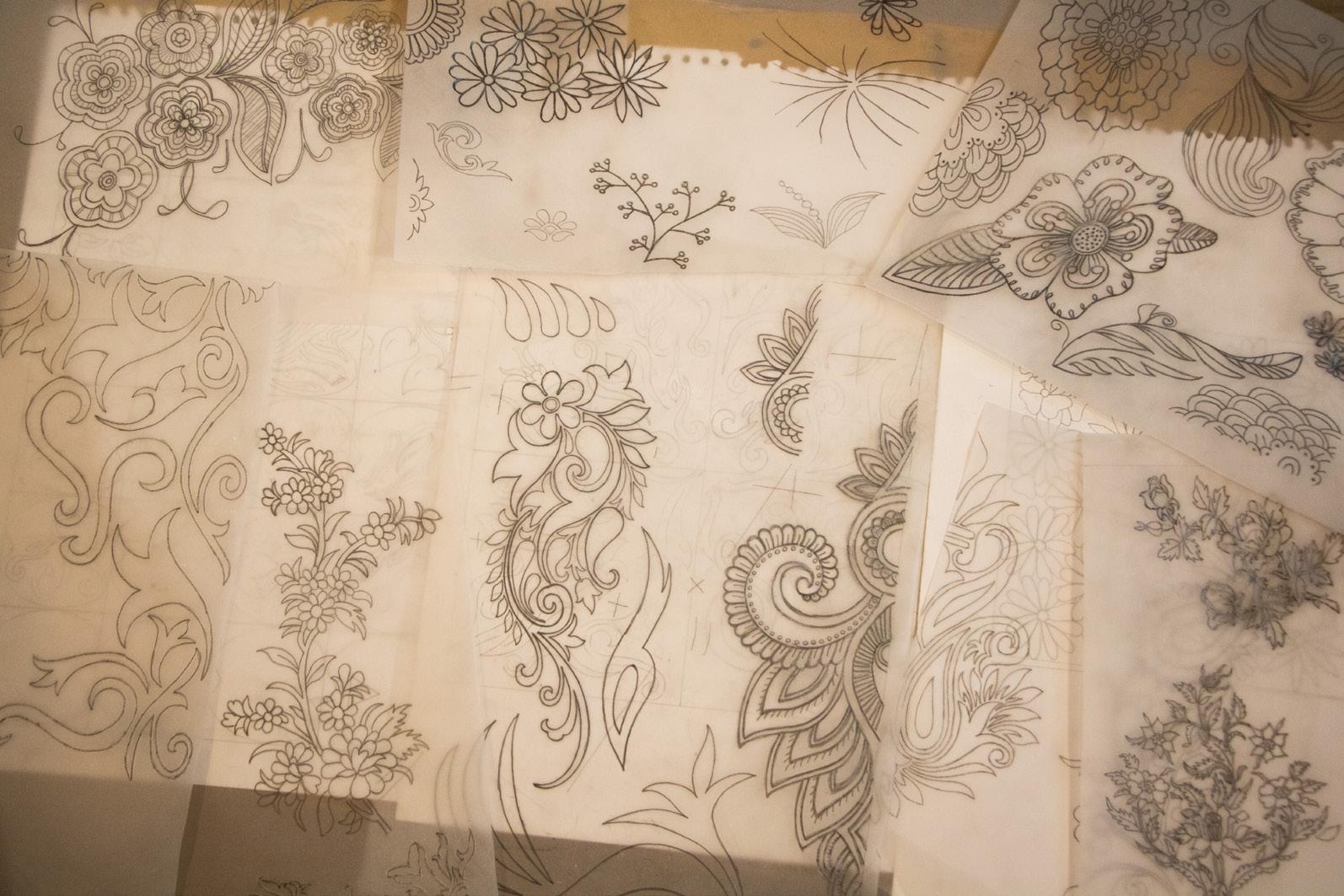
Impact of the multi-media art workshop
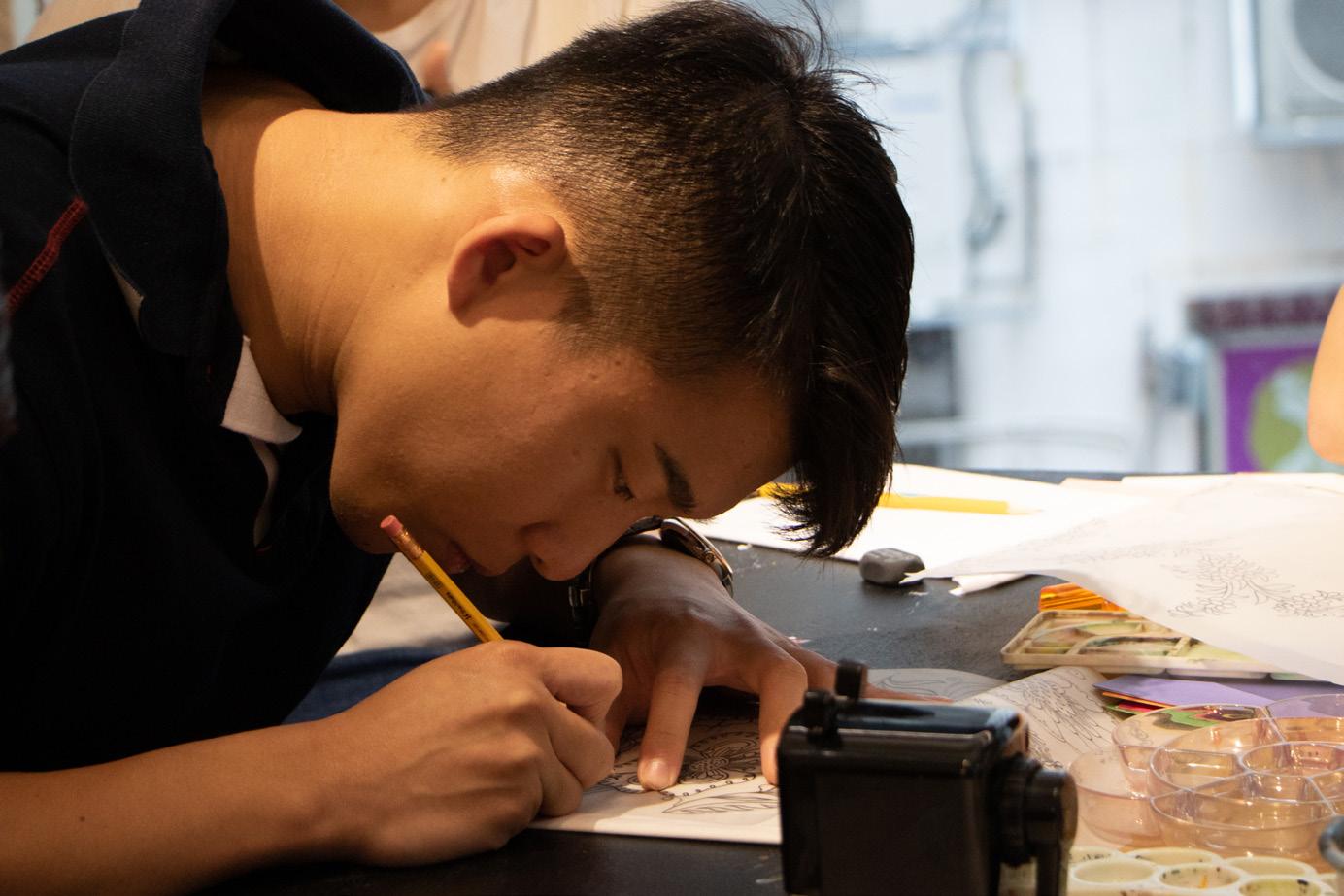
The workshop provides a platform for refugees and locals to share art skills. It builds up a sense of belonging on local community and their relationship becomes closer. Also, it facilitated a new relationship: teacher and student. The talent of the refugee is acknowledged while he teaches the participant to paint. When the locals appreciate the refugees’ art piece, the refugee’s skill is reaffirmed and his self-esteem increases.
Conclusion
To conclude, most of the stakeholders give us positive feedback. In this pilot test, refugees can gain a lot of self-confidence and appreciation from teaching the local participants Mughal art. On the other hand, local participants can learn more about the refugee’s life and their own story through discussion and can learn the specific painting skill. All of them are very devoted to the activity and make a good result. After collecting different stakeholders’ feedback, we have learnt how to improve the pilot test in the future. Also, we found that facilitation techniques, specific skill provider and tool provision are important for the multimedia art workshop. The teacher and student relationship between refugee and local is established. Through this platform, refugee’s talent can be appreciated.
dots. 116 117
03 Connection
3.1 Multimedia Art Workshop
Introduction
Based on the research findings from the meal assistance, we found that refugees have their unique cultural assets compared to local. Apart from that, they are willing to share their own cultural experiences and knowledge, such as their story, food culture, and cooking techniques. Some of them are also interested in cooking or food-related issues as well.
Objectives
Our pilot test successfully matches the participants for this type of activity i.e. Academy subject. It can facilitate the client's unique cultural and experiences from refugees, and the interests of the locals. Towards their cultural diversity we could build up a cooking platform for both. By using the sufficient resources from CA, they could recruit participants from different backgrounds, and provide a flexible space to hold this community kitchen.
Preparation
Before our first workshop, we want to allocate our rundown in a more flexible way. We found out that the time is tight for a cooking workshop within 2 hours, which included thinking the dishes, cooking and sharing etc.
Pre-pilot test
We held a pre-pilot test in PolyU V1120 (social design studio) on 10/23 at 19:00 to 22:30pm. Based on our evaluation, we amended some changes to the schedules on the run down.
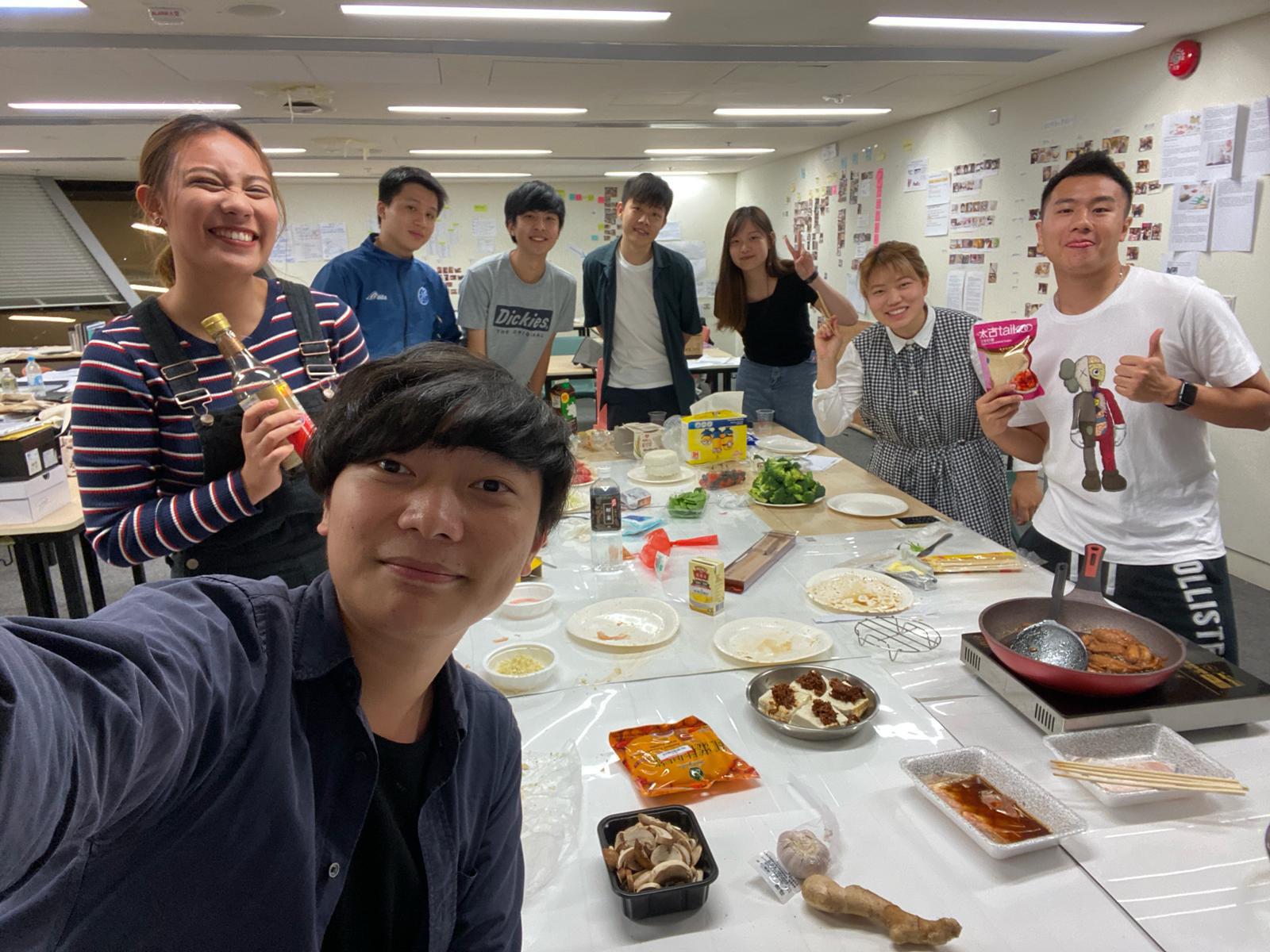
Concerning about the communication opportunity between participants can be carried out or not. The participants may not be very active to speak up in the beginning of the workshop. Being a coordinator, we need to figure out which part is the most difficult for them. And we try to remarks, in order to raise our attention to these problems.
Material preparation
Based on the limitations, We have made some changes about the process of pre-pilot test.
The first limitation is the location. As we held the workshop inside PolyU, there are no shops and a supermarket nearby, which could not fulfil the process of “ingredients buying”. Therefore, we have skipped the “Buying Ingredients” process, and replaced with providing different kinds of ingredients for participant to choose.
Second, in order to lower the uncertainty of the workshop, we only recruit our classmates to act the role of local participants. The reason why we do not invite the element of refugees because we want to make sure the rundown go smoothly. Moreover, we tried to start with small group for the whole cooking process.
dots. 119
3.2 Community Kitchen
118 03 Connection 3.2 Community Kitchen
Pre-pilot test
Pre-pilot test flow
The pre pilot test mainly formed by three parts- discussion, preparing and cooking session. The discussion acts as an introduction of the activity, since we found some students are new to others, it is a good time for them to meet new friends by self-introduction and sharing their cooking experience. (We invited participants who are interested and experienced in cooking, and who don’t have any experience of cooking)
Phrase 1 - Discussion
The participants were asked to discuss what dishes they want to cook based on the ingredients we prepared. And we found that they engaged in the activity very fast, and they can quickly decided what to cook and who are responsible for different dishes.

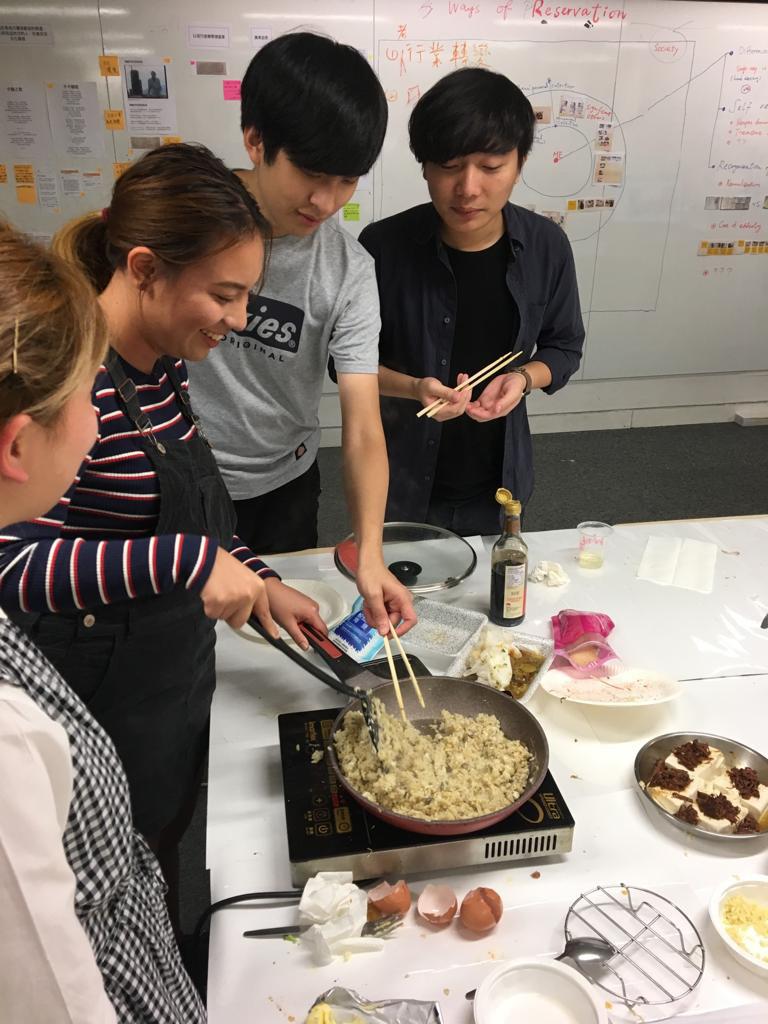
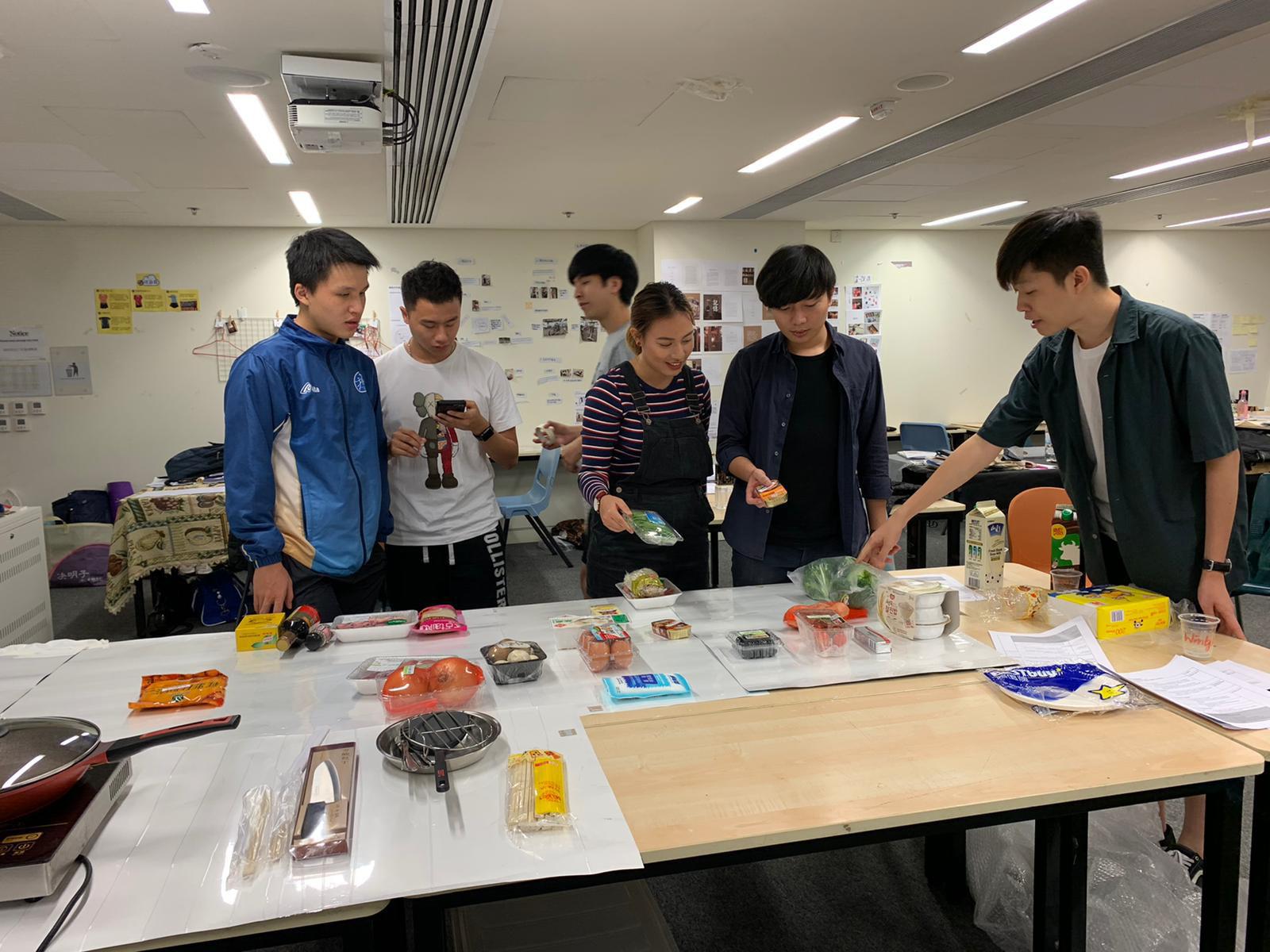

Phrase 2 - Preparation Then, they started the preparation session, it includes the steps of chopping, seasoning, washing, etc. Since there were limitations when cooking in the design studio, we spent quite a lot of time for the preparation.
3.2 Community Kitchen
Phrase 3 - Cooking The cooking session and the preparation basically are repeated and happened at the same time since there are one pan, we need to shorten the time. When someone cook, other participants may start preparing the next dishes. The cooking part is basically depends on the one who cooks and the discussion before.
Phrase 4 - Preparation
We had a tasting after we cooked. The dishes are successful in general. After that, we rounded up and shared the impression of the activity in a circle. Everyone enjoy the cooking and sharing sessions.
Improvement of the rundown of pilot test Modification of the schedule
We have modified the process in the rundown. Firstly, because the workshop is overrun around 1.5 hours, we decided to set limited for the dishes to be made. According to the pre-pilot test, participants made a total of 6 dishes in three and a half hours. And we thought the difficulty of the dishes could affect the time we spent. Based on our test, we will set a time limit for participants to make their dishes. Participants should be based on the time limit to make some dishes are suitable for the workshop in order to prevent the overrun.
dots. 120 121 02 Version
Connection
The Pilot Test
Objectives
Our pilot test focuses on the cultural exchanges through the cooking process. It introduces the cultural assets of refugees to local through a cooking platform. By letting refugees to share their experiences and cultures, local have a new perspective to look at refugees. Instead of focusing on how much professional knowledge they learnt, Community kitchen provided a place for local and refugees to gain understanding and create community connections.
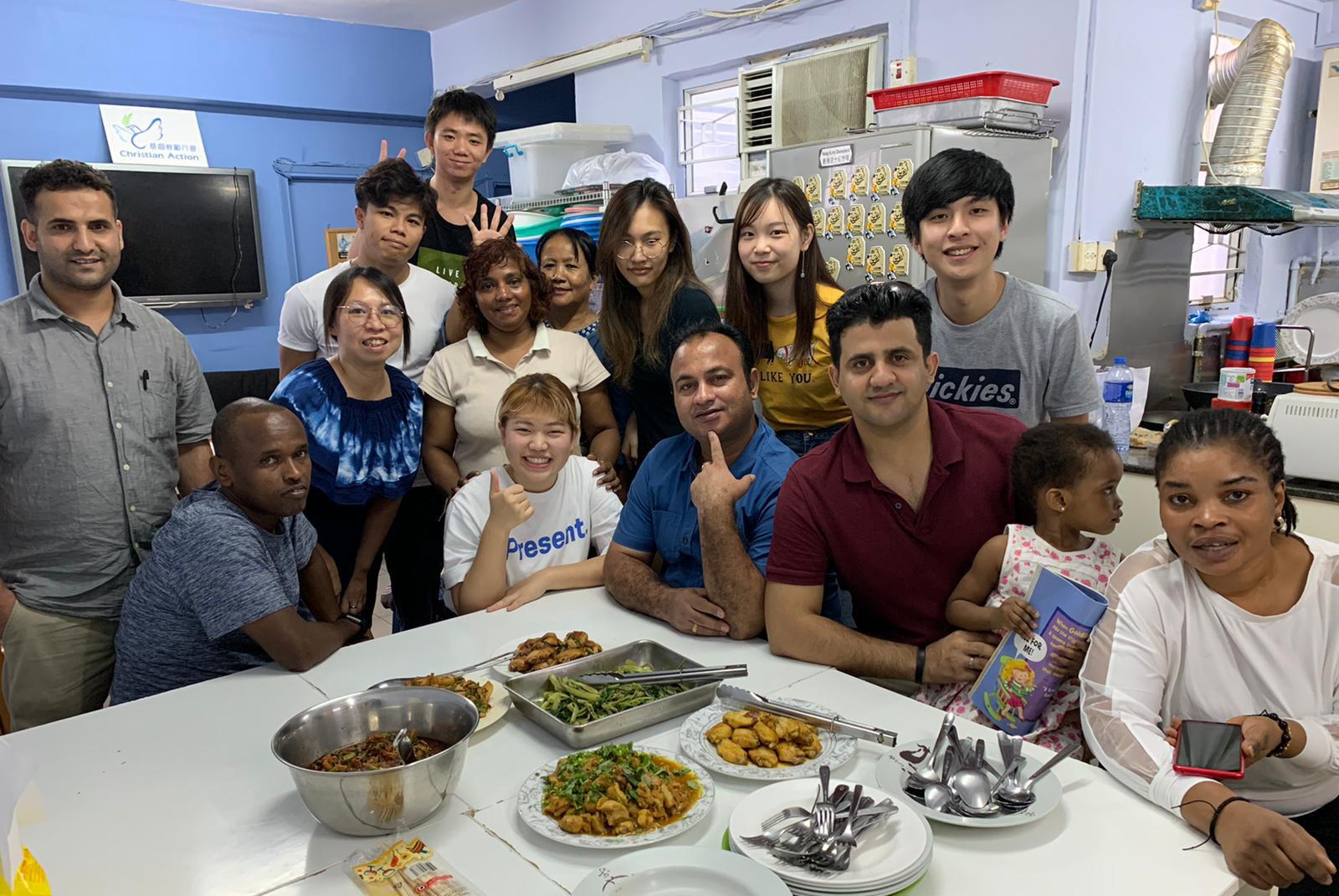
Information of the pilot test
The first pilot test of community kitchen is held at 10/26, from 15:00 to 18:00. The venue of the workshop is in the kitchen in Christian Action and Chung King Mansion G/F.
Preparation of the test
Before the workshop started, there is something necessary that we need to prepare for the workshop. Apart from booking the venue, it included recruitment of refugees and local, ingredients preparation etc.
Recruitment of refugees and locals
We have narrow down the requirements of the participant recruitment. It is because the workshop tries to encourage cultural exchanges on the food culture related. Based on this situation, we only recruit people which is “wellexperienced on cooking”, “interested to cook or food culture” and “willing share to others”. These participants’ traits are trying to bridge the refugees' assets and locals’ interests together.
Ingredients preparation
As the shop in Chung King Mansion only provided a few kinds of ingredients, such as vegetables, some indian flavours, we have to prepare some ingredients before we start the workshop. Therefore, we choose the wet market in Hung Hom, to prepare the ingredients needed, for example, the meat, some local flavours such as fermented bean curd.
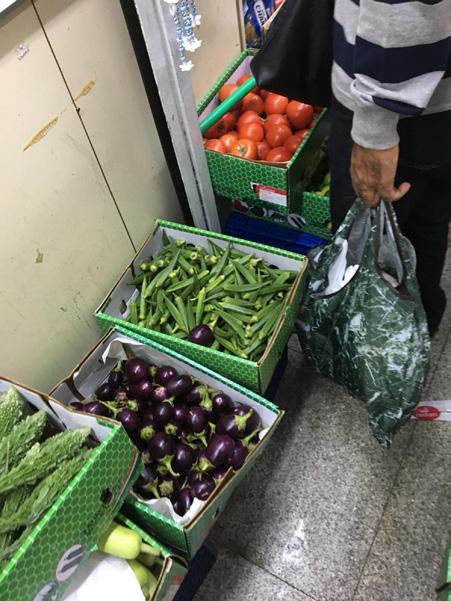
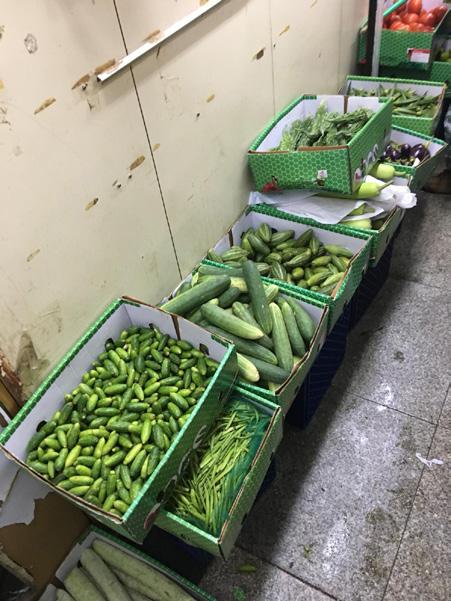
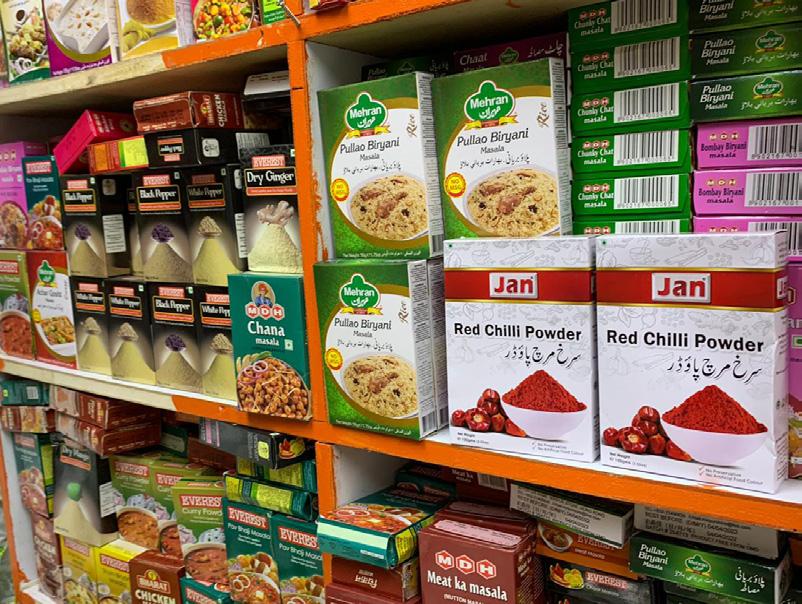
dots. 122 123
Ingredients can be bought in Chungking Mansion
Pilot test 3.2
Community Kitchen
Expected pilot test flow
Pharse 1
15:00-15:10(10 mins) Self-introduction
Introduce your background, come from where, interests etc. The reason why they participate to this workshop
Briefly talk about experiences related to cooking
15:10-15:25(15 mins) Design the dishes made in the cooking session discuss about what ingredients will be needed (included borrowing from CA or buying in Chung King Mansion) Student in charged (PolyU students) will provide some directions when the discussion does not go well
Pharse 2
15:25-15:50(25 mins) Form groups to buy specific types of flavourings in Indian Shops
Group size: 2 locals +2 non-local form a group with 2 in charge Buying in the mansion
Pharse 3.1
15:50-16:00(10 mins) Discuss about what we bought Included some details for specific ingredients?Experiences from locals and clients about their cookings
16:00-16:25(25 Mins) Process of preparing the ingredients
Cooking together (cutting, flavouring washing ingredients etc.)
16:25-17:10(45 mins)
Phrase 3.2
Share skills about cooking
Introduce the dishes step by step during the cooking processes (either clients or locals)
15:10-15:25(15 mins)
Design the dishes made in the cooking session Discuss about what ingredients will be needed (included borrowing from CA or buying in Chung King Mansion) Student in charged (PolyU students) will provide some directions when the discussion does not go well
Phrase 4
15:25-15:50(25 mins)
Form groups to buy specific types of flavourings in Indian Shops Group size: 2 locals +2 non-local form a group with 2 in charge Buying in the mansion
Pharse 4.1
17:10-17:25(15 mins)
Tasting the dishes
Sharing views about the dishes
Washing the dishes after the meal
Sharing thoughts about the whole activities Q&A
dots. 124 125
03 Connection
3.2 Community Kitchen
Pilot test flow in reality
In real-time flow, sessions are overlapping with each other.
11:00-13:00
0 - Preparation
PolyU students went to buy the ingredients from Hung Hom Wet Market before the activity starts. For example, the meat provided for making main dishes, the ingredients and materials needed for making desserts. After we finished buying those ingredients. We brought all the things to the Kitchen of Christian Action, and have some preparation to thaw the meat.
1500-1530
1 - Ice-break & introduction
Participant assemble in the kitchen in CA. Each one introduced themselves and started discussing about their own experiences and culture related to cooking.
15:30-15:50
2 - Designing the dishes
After introduction, participants are divided into two groups, each group are required to cook 2 main course dishes and 1 vegetable dish. Then they have to discuss what dishes they were going to make and the ingredients needed.
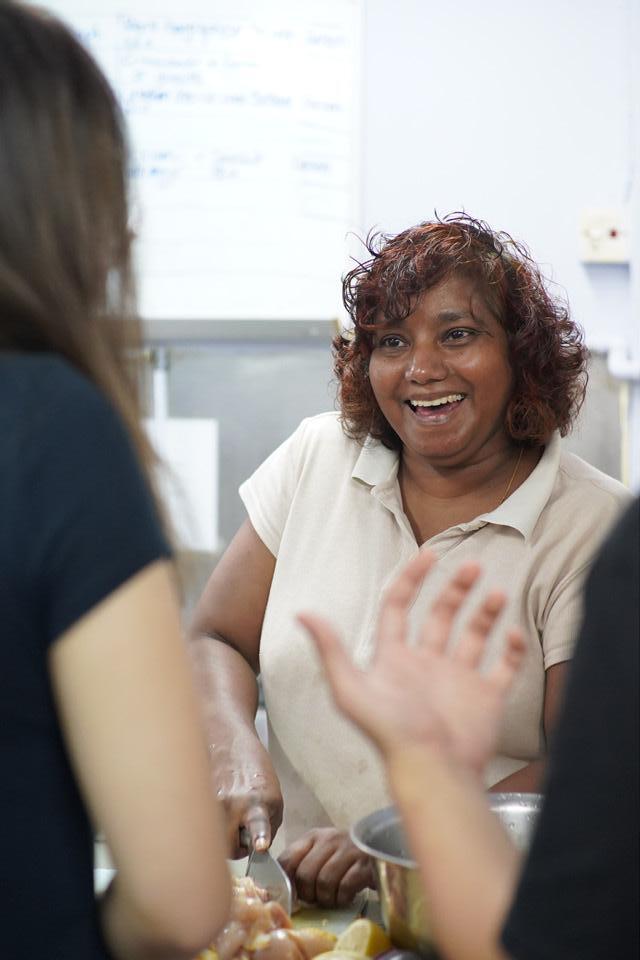
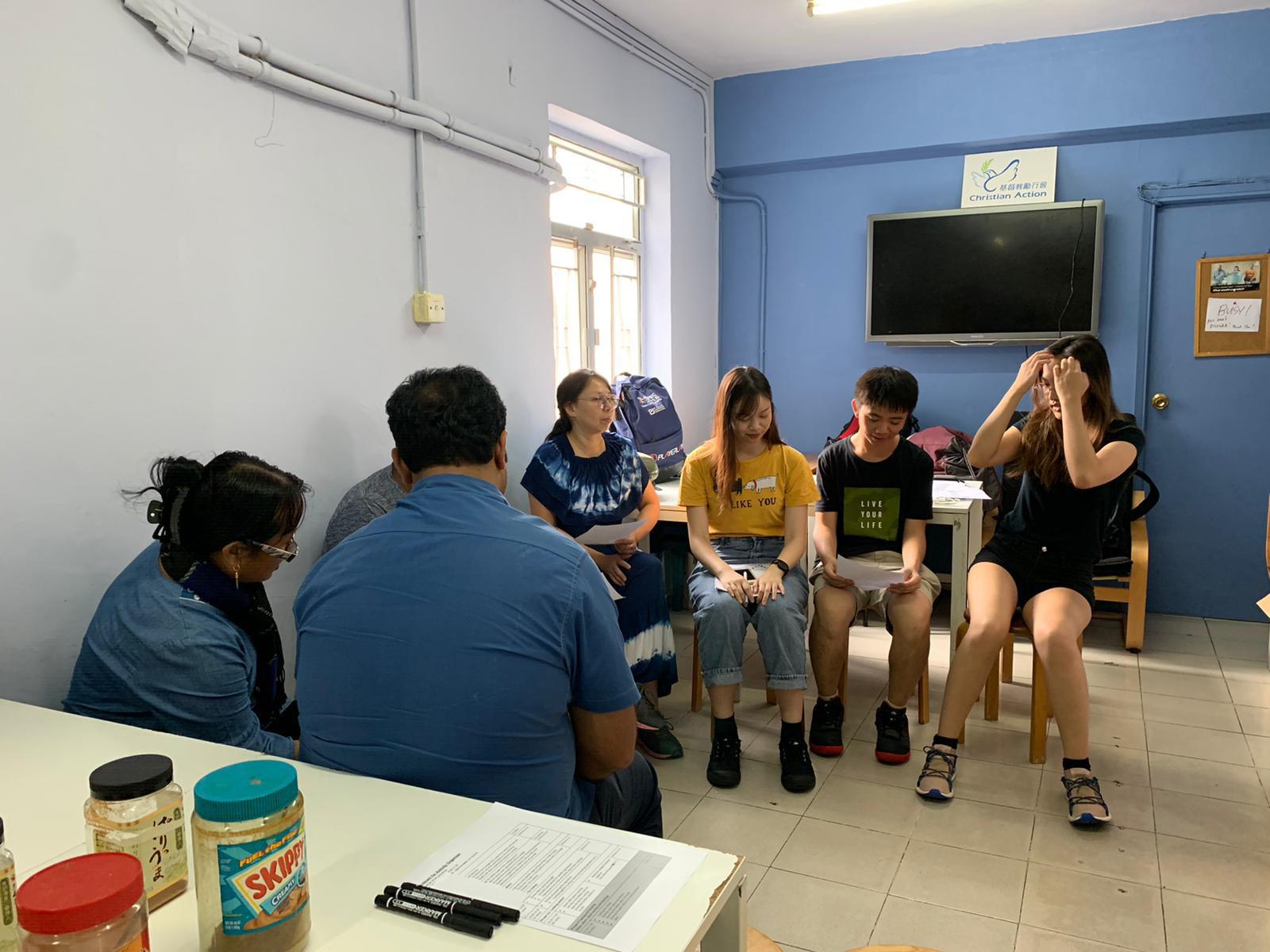
15:50-17:30
3.1 - Buying and preparing the ingredients
Some group members can go down and buy ingredients needed in the shop at Chung King Mansion G/F. The rest of them can stay in the kitchen and prepare for the ingredients that we prepared. Participants can start cooking when they are ready.
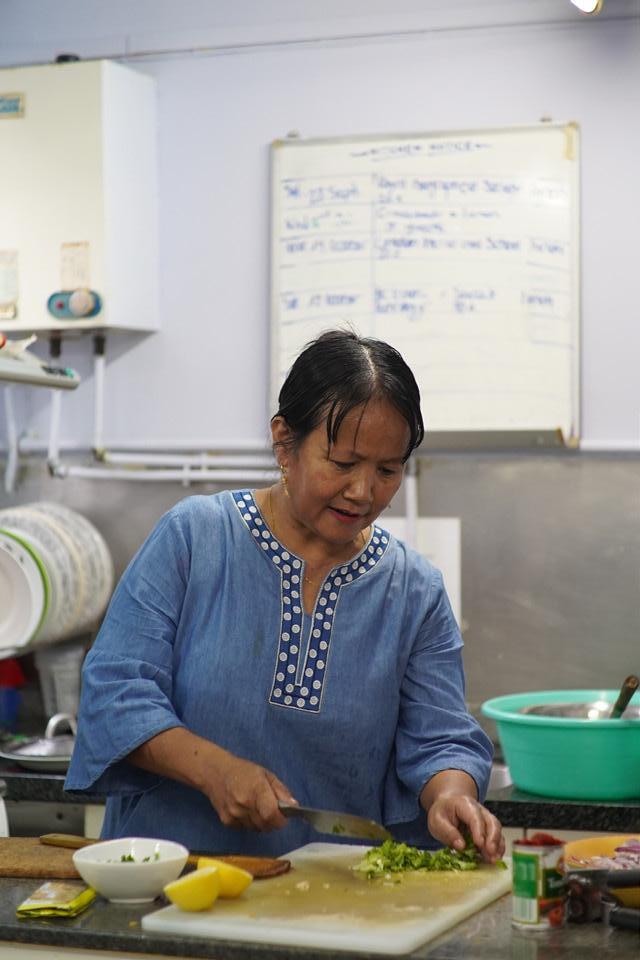
3.2 - Cooking the food
Each group started to cook their food by sharing two cooking stove. As the cooking stove is not enough for every dishes, some dishes would be encouraged to use different methods to cook, for examples, using the oven of the kitchen.

dots. 126 127
03 Connection
3.2 Community Kitchen
16:15-17:25
4 - Desert time
During some participants were making the main dishes, we have prepared some ingredients for making the dessert, Serradura, for the rest of people to make together.
17:30-1745
5 - Tasting and Sharing Session
After finish cooking all the dishes, we put these dishes together and started the tasting session. During this session, participants start different conversations while eating. Because of the overrun of time, we did not have a formal sharing and debriefing session after tasting the dishes.
Outcome
Food and interaction
For the first activity, we found a phenomenon of dishes belongs to one specific countries, since the refugees comers are from different, we all cook their famous dishes which is a mixed cultural exchanges.
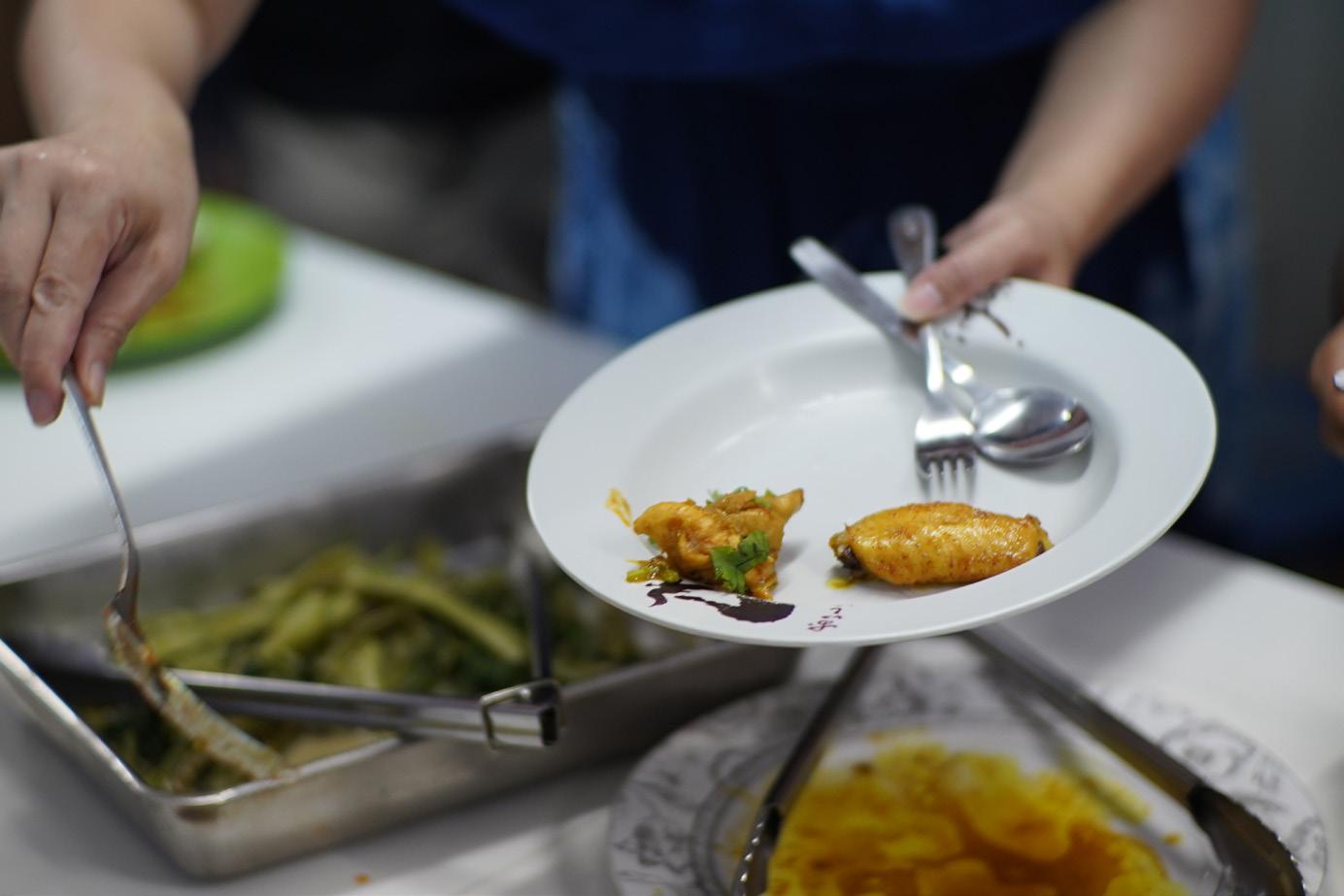
Moreover, the tracing paper provision is really important to the art beginner. According to the first pilot test, the participant thinks the drawing process is too slow because he had to start sketching. Learning from the past experience, we hope to reduce the drawing time. Therefore, we suggest Naveed prepare some tracing papers so the participant can copy the pattern on the fabric. Although the pattern can be simplified, most of the participants finished half of their work when the workshop ends. Therefore, the multi-media art workshop should offer professional tools to participants.
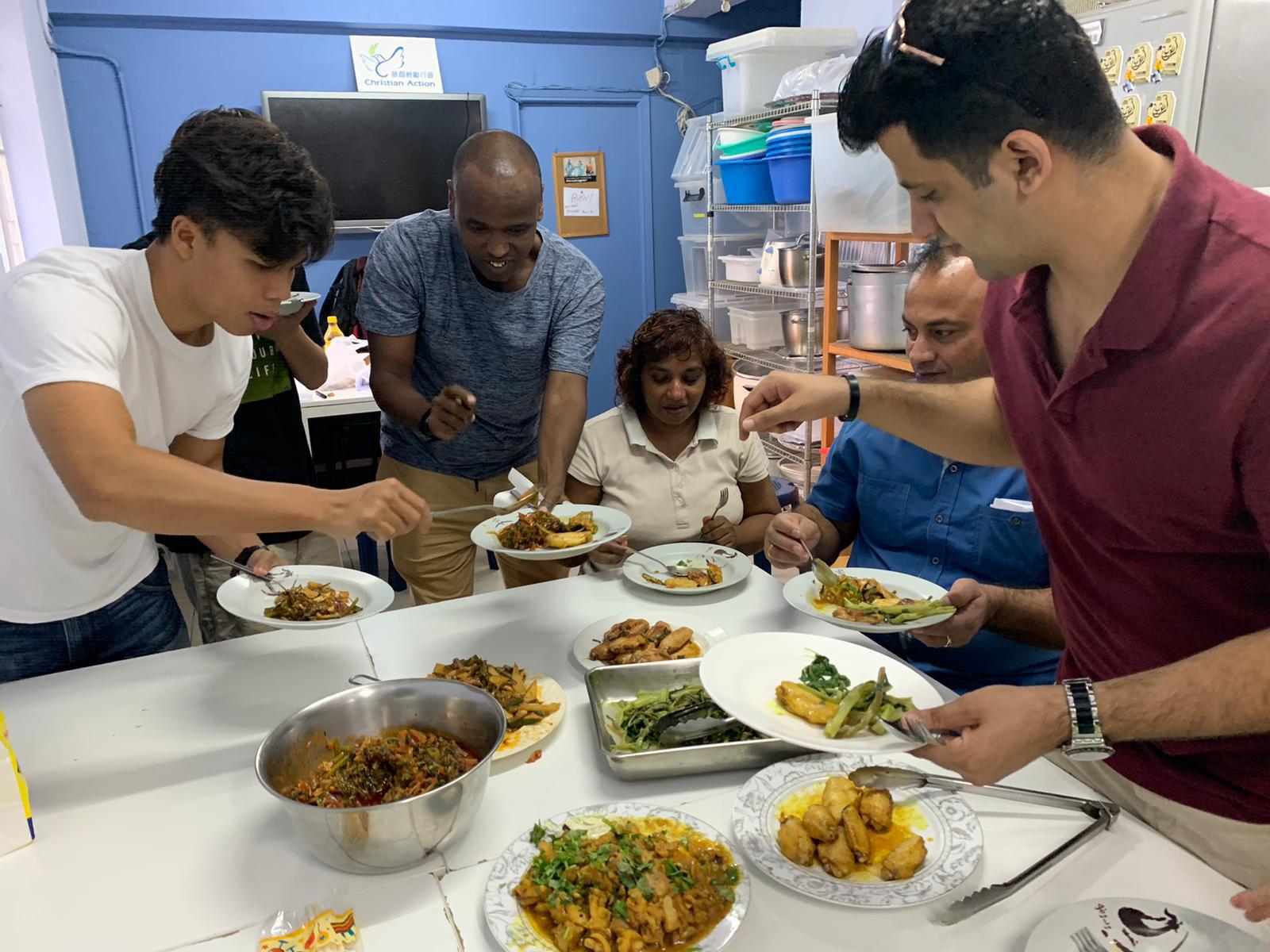
dots. 128 129
03 Connection 3.2 Community Kitchen
Activity dynamic
Party atmosphere
It contains the atmosphere of enthusiasm and the whole process, everyone including locals and refugees is so happy with it and they treasure them a lot. Besides, we provide many opportunities to express their feelings, from one big group to talk about their names and cooking experiences, to individual chats to specific people is also allowed. The whole activity ran like a party, you can pick different from the different country you want. Since the refugees and locals shared the food /outcomes they created together, it is easier to let rise the acceptance of each other. In the present stage, it is a one-off activity that the relationship between locals and refugees are partners, if the activities run a few more times, their relationship can be changed to a friend, a more stable friendzone can be established, and the community will be enlarged.
Participants' Feedbacks
Feedbacks from locals
From locals, they mostly believe the activity widen their horizon, during the cooking process, they realised the new dishes names from different countries, and some cultural differences with the cooking method, for example, they fry up the pan by herbs, while we usually do that by oil, which they found so interesting and they will try by themselves.
Besides, they also provided some suggestions for our rundown, they hope to have a longer time for the introduction part so that they can interact and know more deeply about the refugees.
Feedbacks from clients
From clients, they thought it was a great opportunity and they are so glad to join, which can share happiness and enjoyment together like a big family. They also asked for another community kitchen right after the pilot test.
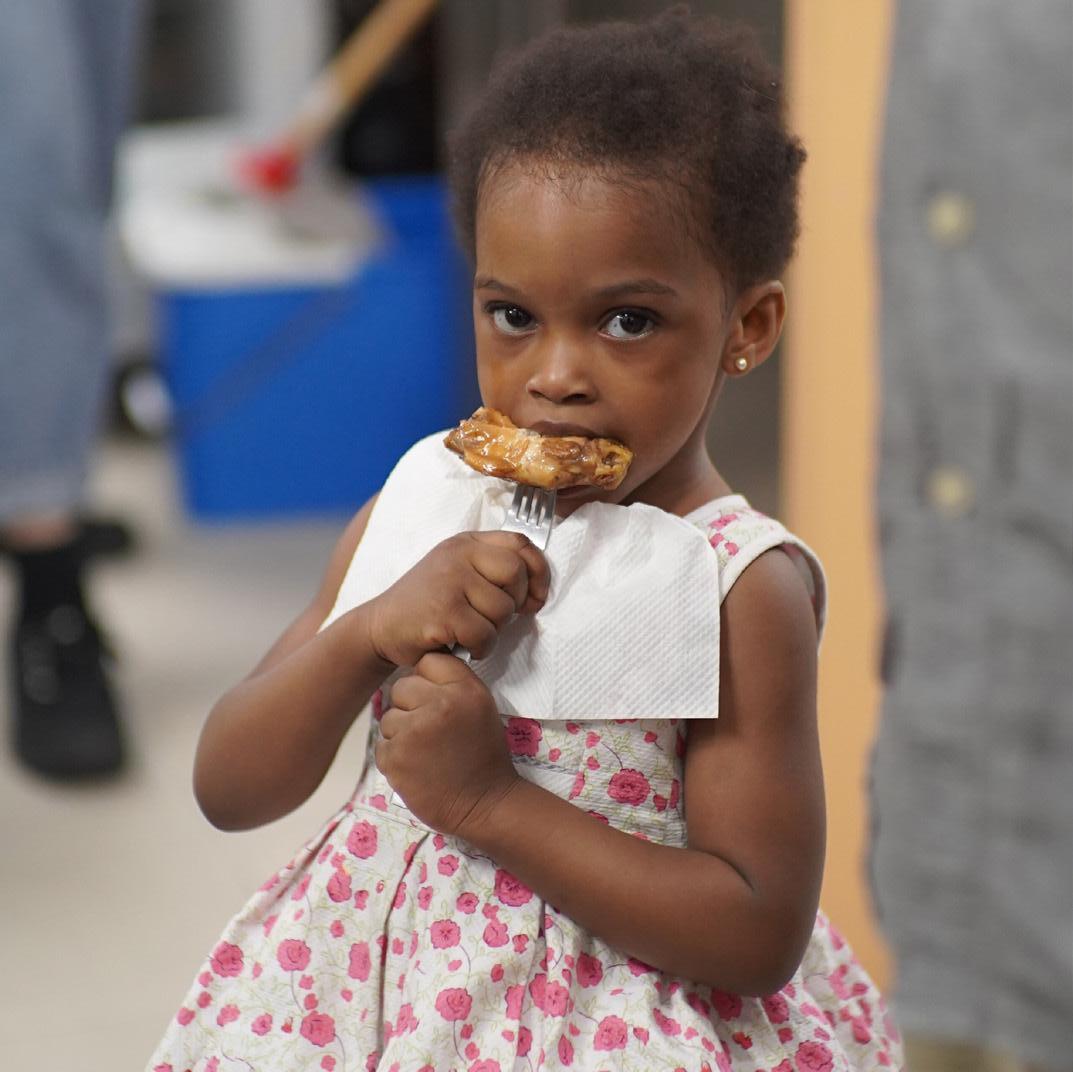
Our observation
Both refugees and locals could do cultural exchanges through the cooking and sharing session of individual backgrounds. For the cooking culture, they learnt the cutting method that is different from the usual way; the refugees are also being active in sharing their hometown dishes, which we think is a succeed of using “cooking” as a medium to be the common topic, indirectly raise their sense of belongings. For the individual background, they not only can express their opinion throughout the sharing session/ introduction part we designed, but they also chatted as a small group or individually inactive, which is a good phenomenon for a 1st pilot test running for the first time.

dots. 130 131 Evaluations
03 Connection
3.2 Community Kitchen
Findings: Improvements of the pilot test
Awareness to different cultural Taboos
We discovered that we should be more aware of the cultural taboo of participants. In the pilot test, we experienced that some participants cannot taste the alcoholic dishes because their religious background. This situation happened because we assumed the participants would be aware to during the discussion.
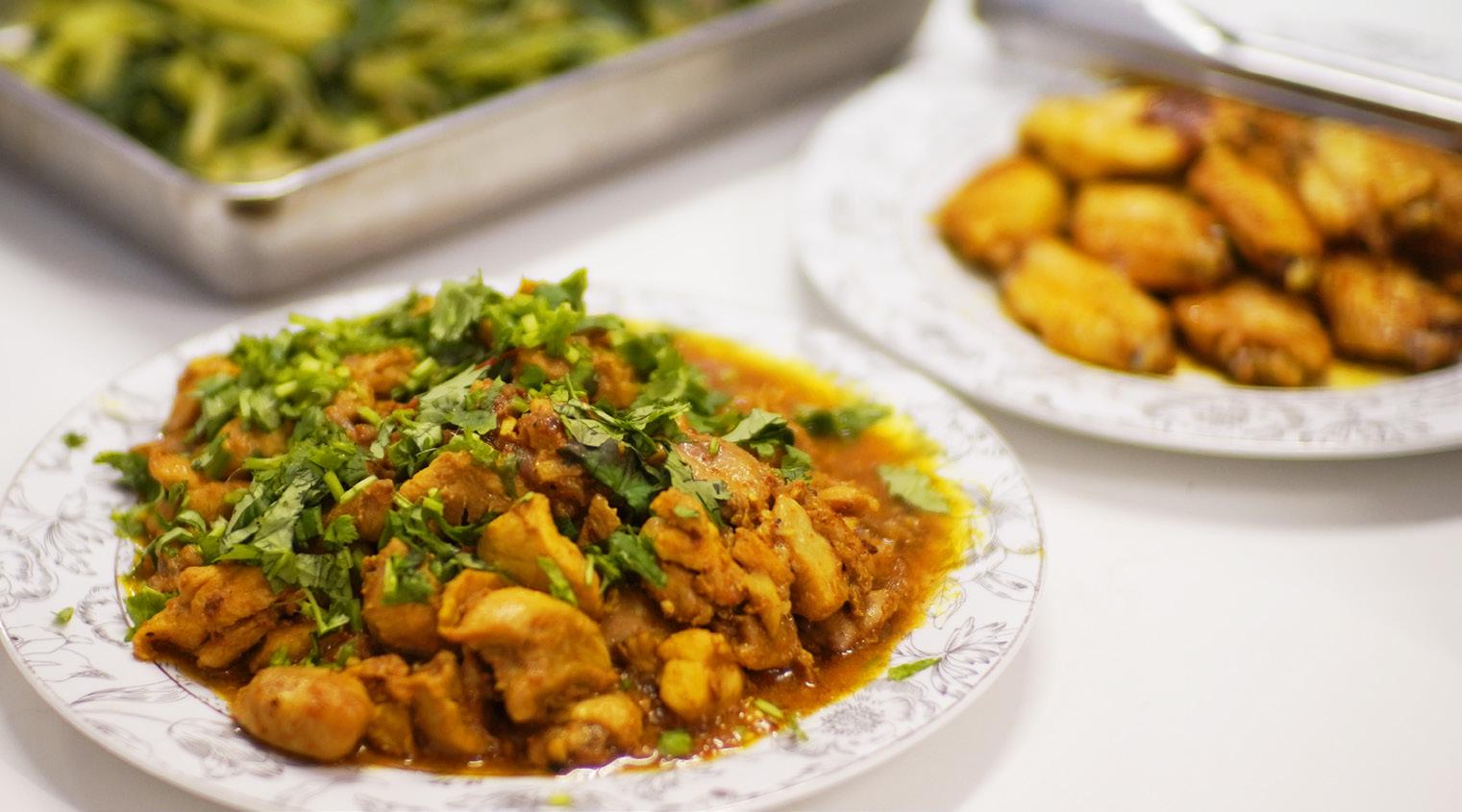
In order to avoid this situation, facilitator should raise this discussion before designing the dishes. The participants can be able to come up with a list which is suitable for everyone, and also shows respect to others background. It would also provide more opportunities for participants to understand different cultural background from these discussions.
Kill-time activities during others cooking
Some participants were losing the direction after they finished their work. They will sit at some corner and use their mobile rather than talk to other participants. In this case, it is better for us to have interactive activities, such as discussion, or some games which are related to their cultural values.
Time control
Compared to the expected time flow, we have overruned about 20 minutes during the introduction. Apart from that, the time cost based on cooking different dishes would also affect the smoothness of rundown. As an example, during the middle of the workshop, one group has already finished one dishes with only a few procedures. However, another team were still preparing their ingredients as it is more complex compared to the first dishes. In order to make a better time control, we should increase the spare time for some session, in order to increase the flexibility of the whole workshop.
dots. 132 133
03 Connection
3.2 Community Kitchen
Introduction
In Gordon Matthew’s class, we found that the participants have a strong sense of politics and they were willing to share their own stories and perspectives. We also recognised that those stories and thoughts were worth to be heard. Discrimination and stigmatization often happened on them, however, they would rather keep silent. Therefore, we thought storytelling is a platform for them to voice out for themselves. By integrating locals and clients from C.A., better conversation and interaction can be facilitated. Instead of discussing political and social issues, sharing personal experiences and stories is an ease to expose themselves.
Objectives
‘Storytelling as a platform to identify themselves and to unleash their potential.’

Storytelling enables locals and local refugees to have cultural exchange and mutual understanding through sharing personal experience in daily life. Both locals and refugees are the storyteller who actively initiate the conversation on their own. Participants can benefit from each other by exchanging ideas and thoughts on specific themes. It in turns can constitute the social network and connection among them.
We have employed two pilot tests on 23 Oct and 2 Nov in an attempt to evaluate the effectiveness and feasibility, and also to discover future possibilities of the activities within 2 months. It was intensive, but had diversity.
dots. 134 135 02 Version 3.3 Storytelling
Pilot test
Connection 3.3 Storytelling
This is the 1st attempt for us to get both locals and refugees to share their personal ecperience with each other.
Srorytelling
23 Oct Run-down
7:30 pm - 7:45 pm
/ Greeting & self-introduction
7:45 pm - 8:00 pm
/ Introduce our theme: Interpersonal relationships
8:00 pm - 8:40 pm
/ Free discussion
8:40 pm - 8:55 pm
/ End of session + debriefing
The atmosphere was too serious
For the recruitment part, we are suggested to increase the number of participants, especially the ratio of locals.
The conversation is not easy to hold without a focus
Participants said that we should have prepared a framework of content and provided the background information of the topic. In which, participants would like us to narrow down the topic, for instance, “My Story of Persecution”, “In What Ways Does De-stigmatization Occur?”. By this, the relationship will be bridged naturally, grouping people together by similar experiences. During the workshop, we are judged to brought the participants into confusion. They suggested us to explain the objective of the workshop to ease their ambiguous in the beginning.
It is advised to document the content and show it the next time
We have conducted a survey within all of the participants of the first pilot test. Referring to the results of the post-workshop questionnaires, the comments resulted in three directions are shown on the next page.
For future developments, it is worried that it became one-off workshop. It is advised to document the content and show it . Obviously, the refugees wished their stories could reach more audiences, increasing the sustainability of the workshop. Moreover, the form of workshop is recommended to be social inclusion community making, co-creating by both locals and refugees.
dots. 136 137
1st Pilot Test
Feedback 03 Connection 3.3 Storytelling
The error found in pilot test: the gap which help our team to scheme events in the future.
Amendments for the Next Pilot Test
Storytelling
Arranging Diverse Participants into the Sessions
In this session, we found that refugees are more willing to share while local were tend to be quiet. Therefore, we may need to invite more locals to come. By promoting and publication, we want to attract more parties to participate in the sessions. Instead of the invited participants, we also expect their families and friends can also be involved. People from different age groups can share different perspectives and to evoke wider topic.
Generating more interesting response in neutral conversion
In order to construct a lively and casual atmosphere, refreshments are served. We also expect storytellers can move around to show their pictures or writing on the whiteboard. The role of moderator is to encourage and initiate storytellers to share their opinions. Therefore, some leading questions and personal stories can be raised to further expand the topics.
Making use of conversation objects
In this session, we found that some are more willing to share their opinions while some remained steady. Therefore, adopting conversation objects into the conversation will make the progress more feasible, concrete and interactive. For example, sharing and reviewing photos can recall the memory of the storyteller and the audience can more easily to immerse themselves.
The Division of the Role of Moderator
Organization, initiation and observation are 3 main roles for moderator. For organization, moderator should handle the time management. For observation, moderator should have note-taking. For initiation, moderator has to notice and manage the sign of awkward silence. They should subdue the part of others that is searching desperately for something to say by making transactions, raising leading questions and summing up the points.
Betterment in Overall Run-down
Since there is no clear run down and planning before the pilot test, the sessions became a bit loose. Introducing the background of the Refugee Academy would be necessary for participant to involve into our activities. Furthermore, time management is essential for us to handle the process of sharing sessions.
dots. 138 139
03 Connection 3.3 Storytelling
In this session, we had organised an agenda for discussion. Before we got into the topic, we had briefly introduce Refugee Academy to the participants.
Srorytelling
We explained the meaning and reason of having them by telling them the session is part of our research so that they could have a clearer picture of what we are doing. Moreover, in order to record our observations, we had specified our roles and duties.

2 Nov
Role and duty
Roles: Moderator + Initiator + Round-up
Duties: Observation + Discussion
7:10 pm - 7:15 pm
/ Welcome + Introduction of our project
7:15 pm - 7:40 pm
/ Introduce our theme: Impression of locals or refugees
7:40 pm - 8:20 pm
/ photos sharing
8:20 pm - 8:30 pm
/ End of session + debriefing
Feedback
Positive attitude towards this workshop
“I had never been to similar workshops”
“I felt meaningful that one of a participant was from Iran, never thought that refugees could be in white, so surprising.”
A more interactive workshop is better than holding talk show
“This interactive storytelling workshop is really humanised, comparing with Gordon Mathews’ class tend to be more academic oriented.”
The time for discussion is adequate, although all of them showed unwillingness to leave
“What?! It comes to an end? I thought it has just started!”
Both coordinators and participants keep their conversation going after the workshop ended.
Participants are keen on building relationship with each other
“By knowing that political problem is the only reason why they are here, I gained a deeper understanding towards refugees. Their experiences could definitely draw out my interest!”
dots. 140 141 2nd
Pilot Test
Run-down
03 Connection 3.3 Storytelling
Our objective purposes to bring out cultural exchange and mutual understanding through sharing personal experience in daily life, and constitute the social network and connection among them.
Post-workshop: Evaluation
Storytelling Pilot Test
Our objective purposes to bring out cultural exchange and mutual understanding through sharing personal experience in daily life, and constitute the social network and connection among them.
We regard storytelling as a channel for exchanging ideas, enhancement in mutual understanding and rebuild the connection between locals and refugees. However, we could only recognize the participants had positive change towards the impression of refugees after the chance of communicating.
Undoubtedly, we should note that social impact is not an immediate effect, and the effectiveness does take time. Yet, our aims has been reached. The interaction and relationship between refugees and the locals was expedited. In which, both locals and refugees involved as the storytellers who actively initiate the conversation. In addition, both parties benefit from each other by exchanging ideas and thoughts on some specific themes. It is hoped that the social network and connection will be constituted among them. To conclude this pilot test, it did bring people together.
Pilot Test 1
Knowledge
Perspective
Pilot
By comparing the outcomes of both test, to find out the rooms for improvement.
dots. 142 143
Exchanged
Understanding Atmosphere
and congenial
in gender identity and role among countries
and hardships living in Hong Kong
Test 2 Mutual
Casual Relaxing
Stigmatisation
Hurdles
towards
and romantic relationship
experience as a refugee in Hong
03 Connection 3.3 Storytelling
marriage
Daily
Kong Outcome
Future Development
Storytelling Pilot Test
i) Art Therapy
Art Therapy offered storytellers a chances for expressing themselves by drawing and writing, instead of words. As we found that some of our storytellers are good at writing and drawing, their work can somehow reflect their own personality and also trigger their sense of creativity and imagination. They then can share their own stories behind the graphics, which can be interesting and remarkable.
Suggested discussion topics
i) Life in Hong Kong
ii) Meditation
Meditating is good for mental health. Living in this hustle and bustle city, citizens find it hard to step back, to relax themselves and to be aware of their internal thoughts. Through practicing mindful meditation, storytellers can have self-introspection and self-reflection at the same time, which can provide them opportunities to exchange thoughts and feelings altogether.
ii) My Hobby
Throughout the sessions, we found that there are many possibilities to further develop the storytelling to a larger extent. Below are some suggestions that can be considered in the future.
Interested Parties
In pilot test 1 and 2, we discover YMCA had research about asylum seekers and local migrants long ago, and so they had exhibition named ‘Rediscovering Tsim Sha Tsui: Crossing boundaries - stories of asylum seekers and migrants’ in their centre.
Some of our storytellers were part of the project and the organization may provide support and man power in future project.
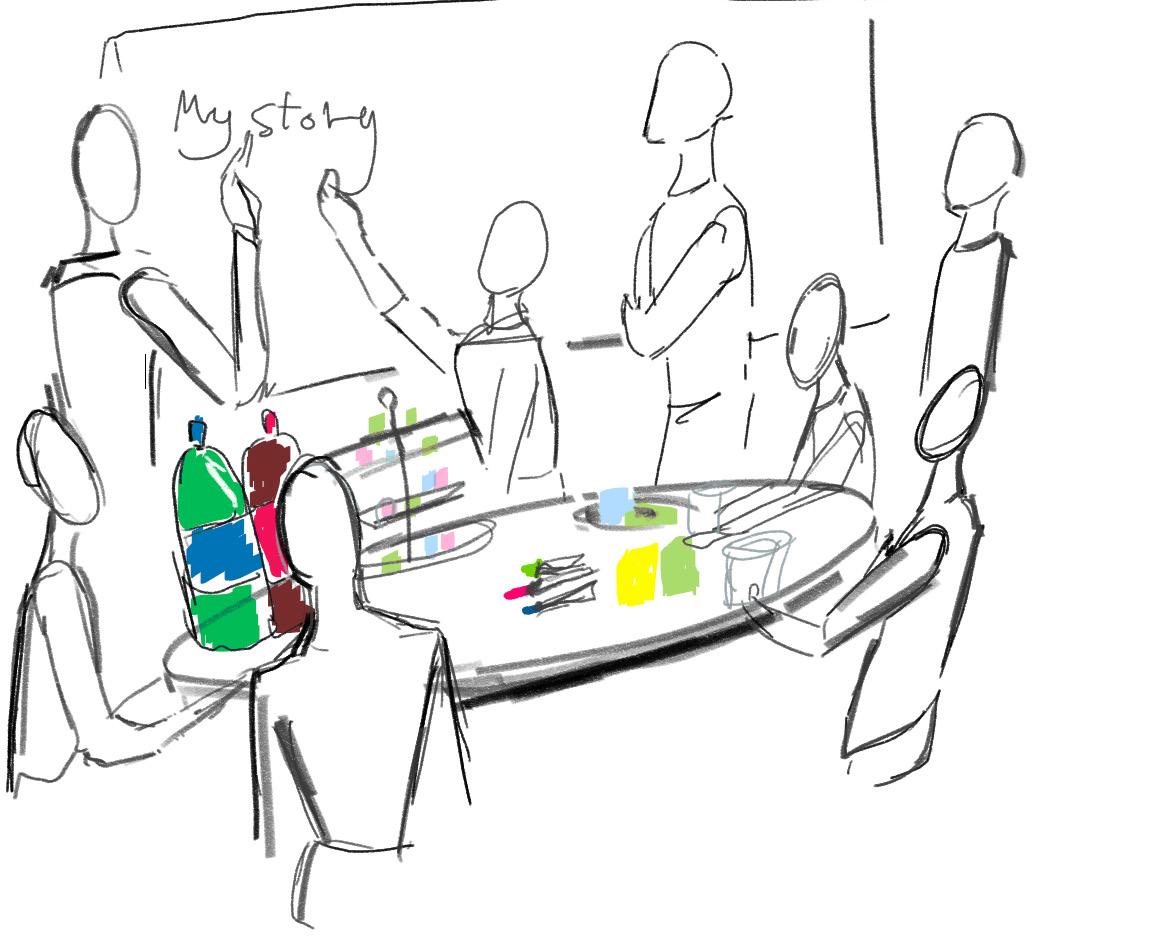
People with diverse culture may have different perception to the same place. Participants are required to bring along with 5-6 photos or pictures to share their local experience.
• Have you ever seen scenes of locals neglecting ethnic minorities?
• Could you tell your experiences of being discriminated against?
iii) Cantonese in Daily Use
The pronunciation is uneasy for the Cantonese learners, refugees could bring along the confusing wordings.
• Have you ever mixed up cha1(fork) and cha4(tea) ?
Each city has its own unique musical instruments or local games. The participants are asked to bring along tangible objects to show the diversity and inclusion.
• Could the musical instrument represent your unique national characteristics?
ii) Language Learning Kit
English is the second language for most of the refugees as well as Hong Kong people. Both parties could sharing their ways of learning.
• Have you ever tried to learn a second language by watching TV episode?
dots. 144 145
Flow of the Activity 1. Greeting and Introduction of theme 2. Activity + Discussion (duration: 90 minutes) 3. Round-up 4. End of session/ Tea party
Feasible Elements to add in the session
03 Connection 3.3 Storytelling
To understanding how storytelling can bring benefits to this community making project.
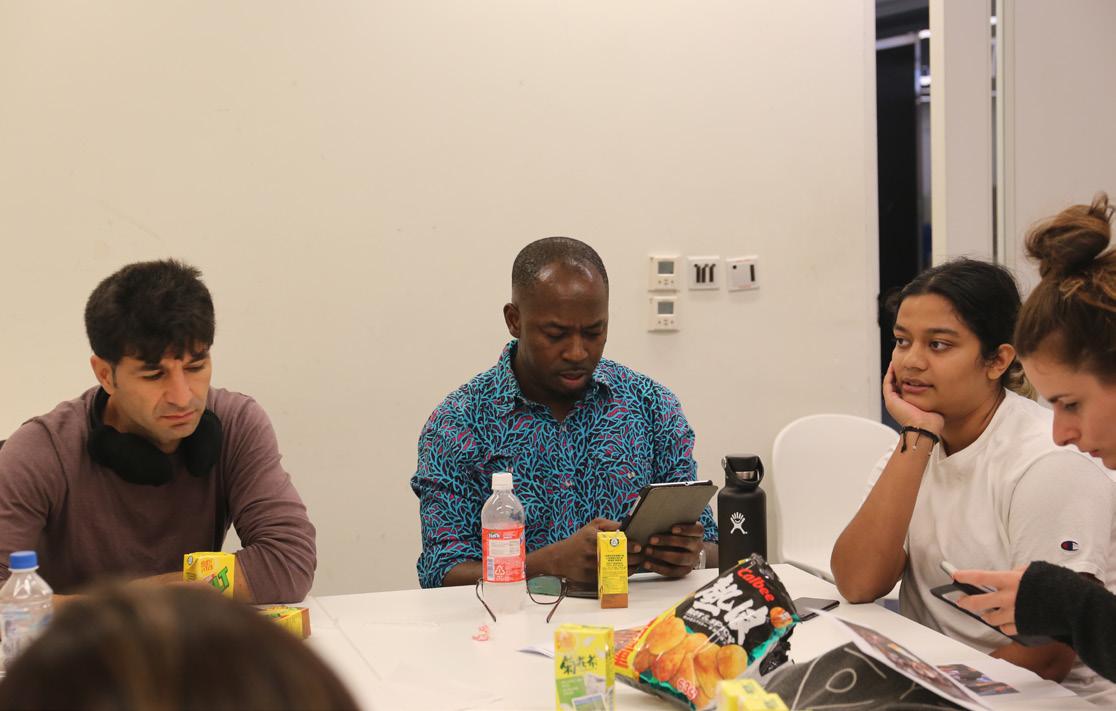
One
Identifying one’s potentiality
Refugee Academy is a platform for refugees to develop their potential. Storytelling can directly gather the information of one’s capacity, which can diversify and enrich the culture exchange in Refugee Academy. Storytelling is the most convenient way to collect influential stories and assemble potential storytellers. By sharing their own interests and learning skills, coordinators can highlight their talents and to figure out how can the strength be further delivered in academy.
Widening and strengthening local community
Storytelling integrates parties from local and local refugees and to promote cultural diversity. By initiating them to become the storytellers, refugees can share stories from their hometown while locals can share their life experiences in Hong Kong. More communication and interaction can be facilitated so that local and refugee can build up mutual understanding of each other. `
Three
Two Fostering Culture exchange
Albeit refugees do not have legitimacy to work and live in Hong Kong, it does not mean they cannot have their own community and social networks. We expect the significance of culture exchange can establish a rapport between locals and refugees. The community of refugees should not only be confined in Ching Kong Mansion, but also in the outsider.
dots. 146 147 Significance Storytelling
03 Connection 3.3 Storytelling
Insights Summary of pilot tests
3.4 3.4 Insights
The overlapping area of refugees and locals
It is proved that our target audience group is valid, there are interested locals and refugees for cultural and other forms of exchange. Most of all, they are within reach even at this initial stage, which is essential to making and forming the community. They are potentially the first batch of community members, who would attend the activities, give feedback and hopefully, ideally, extend further branches of activities after more contact within this active pilot group of members. So far positive comments and proactivity are received from stakeholders i.e. activity attendees, speakers and partner venue owner, projecting a high possibility of recurrence.
Variety of activities & network support
By organising activities of different levels of engagement, forms and medium of exchange, we have tested some of the potential activity settings for the above audience group to come together. Demonstrating some of the possible community-making scenarios, these activities have brought upon insights into the following:
They are doable scenario examples that represent a part of the future possibilities
Activities of smaller scale are highly probable
The activities have opened up and should, in the future, remain fluid enough to open up more topics, themes, talents of refugee and community members, while considering the unstable nature brought by the identity of refugees and asylum seekers i.e. being prone to leaving Hong Kong, their mid-way stop, or other changes of life situations based on their applications. Therefore, to keep connections alive, humanistic and flexible, static or rigid forms of activities that do not favour exploration with the mutable social status of refugees, are not ideal.
Channel for a stable connection is needed
Despite the flexible forms of activities, community-making scenarios, a channel to contain or even sustain them is needed for longer-term development. At this stage, the pilot tests are conducted to evaluate the feasibility, forms and content of community-forming scenarios, but not the breeding conditions of them, which is the reason why we did not carry out formal recruitment and advertisement but rather by the spread of mouth within own vast network of friends and colleagues. A channel or platform should be established as a recognisable mouthpiece between the community and the public at large, which gradually replaces, or at least shares the role of member recruitment, activity information announcement, feedback reception and evaluation, and more administrative, networking, public educational tasks.
dots. 149 02 Version
What we found after doing the pilot tests... 148
How to make a sustainable local-refugee community in Hong Kong?
151 dots. Chapter 3 : Connection
What is/ are essential to make the local-refugee community to be contained sustainably?
dots. 153 Chapter 4 : Sustainability 04 Sustainability 4.1 A communication channel 4.2 Systematic sharing platform 4.3 Communication outreach 4.4 Future imagination
What is essential to make the local-refugee community be contained sustainably?
To make a refugee-local community in Hong Kong, it is tested that it is doable to utilize the scattered and decentred knowledge of the refugees as a starting point to satisfy the curiosity of Hong Kong local people towards the life of refugees. By connecting two parties, some chances of communication are formed, which would help to create trust among the two groups of people. But under what conditions can these multiple-formed scenarios be contained sustainably? It needs an appropriate channel.

4.1 Communication channel between refugees and locals
Communication model
To have effective communication, apart from the sender and receiver, an appropriate channel is essential. In the situation of the refugees and Hong Kong locals, we have sender who is willing to share their disorganised assets and receiver who is willing to learn and interact. However, an effective and efficient channel is missed in the communication process. Due to over-scattered knowledge and numerous of sender and receiver are involved, the possibility for making the mentioned multipleformed scenarios in the previous chapter happen is weak since the contacting points are over-dispersed.
scattered, decentred knowledge of refugees
Therefore, design a channel for distributing scattered, decentred knowledge of refugees is indispensable. Through the channel, disorganized knowledge can be presented in a systematic way. The channel is not to organize the scattered knowledge, but by the centralization, it can find a way out to narrow down the contacting points among the refugees and locals. The receiver can have a simple can convenient approach to learn and interact.
Channel for communication
scattered, decentred knowledge of refugees local living experience, community connections
Receiver HK public
Refugee Academy (RA) is the solution. RA is a sharing system for creating a local-refugee community. It is a sharing platform for refugees to share, for locals to receive and the other way around. Through two-way communication, the refugees can share their assets to the locals while the locals can give back some local living experience and community connections. Effective communication would be formed. Thus, trust among two groups of people can be built and the community would be framed.
dots. 154 155 Chapter 4 : Sustainability Chapter 4
Sustainability
Refugees Refugees Refugees
Sender
Refugees Refugees Refugees
Sender
04 Sustainability
Receiver HK public Channel
4.2 Systematic sharing platform
A systematic sharing platform is essential for making the local-refugee comunity. As mentioned in the previous section, Refugee Academy is the solution. In the following, the platform will be introduced.
Refugee Academy

Aims and objective
Cultivate understanding about diversified beings and identities of Hong Kong people
Provide a secure channel for refugees and locals to establish a self-sustaining social network
Enhance multicultural skills and experience exchange
Characteristics
Customised
Without actual instructions; Flexible learning procedures
Anytime, anywhere
Learning in non-fixed schedules and locations
Condition-related
Making use of the materials and facilities they have for the learning themes and contents
Two-way learning
Equal experiencing opportunities provided; Learning with each other interactively
Fun & friendly
Interacting in amusing environments; A bridge for making friends with each other
157
4.2 Systematic Sharing Platform
04 Sustainability
Roles of Refugee Academy
Link up refugees and locals
RA would work as a mediator to facilitate the communication between the refugees and locals. By contacting refugees who are willing to share and meet friends, it can link up the local side through activity promotion. Therefore, RA is charged with the understanding of refugees and locals. What refugees can share and what locals would like to know is examples of the considerations.
Create a local network
RA would act as a networking hub for connecting all interested parties, including local small communities and organization. We believe that community cannot be built independently. Therefore, we welcome all interested parties, such as venue provider and enterprises, for joining us to develop a diverse community.
Provide materials and resources
Since refugee is a sensitive group in Hong Kong, some administrative and law issue will be implicated. RA is responsible for protecting the rights of refugees, including transportation fees and some law grey areas. Besides, RA is accountable for providing the resources for knowledge sharing sessions, such as the content of the sharing session, teaching materials, venue of the activity and money for administration.
4.3 Communication outreach
Communicate with the public
RA would work as an official channel for representing refugees to communicate with the locals. The main communication goal for RA is to promote the knowledge sharing sessions will be held to the public. It is a channel for inquiries and answering questions. Also, RA is responsible for improving the image of refugees by solving the misunderstanding behind.
Create chances for communication
Refugee Academy as a communication channel for the refugees and locals, online communication will be the way out. Outreaching the information is essential for the channel. Since above-the-line (ATL) communication can reach a mass audience with little budget, relying on social media platforms is the possible solution. Therefore, a Facebook page will be created as a medium for communication. Apart from the online platform, some below-the-line (BTL) will be done in order to reach more Hong Kong local public.
dots. 158 159 4.3 Communication Outreach
04 Sustainability
Above-the-line (ATL) communication








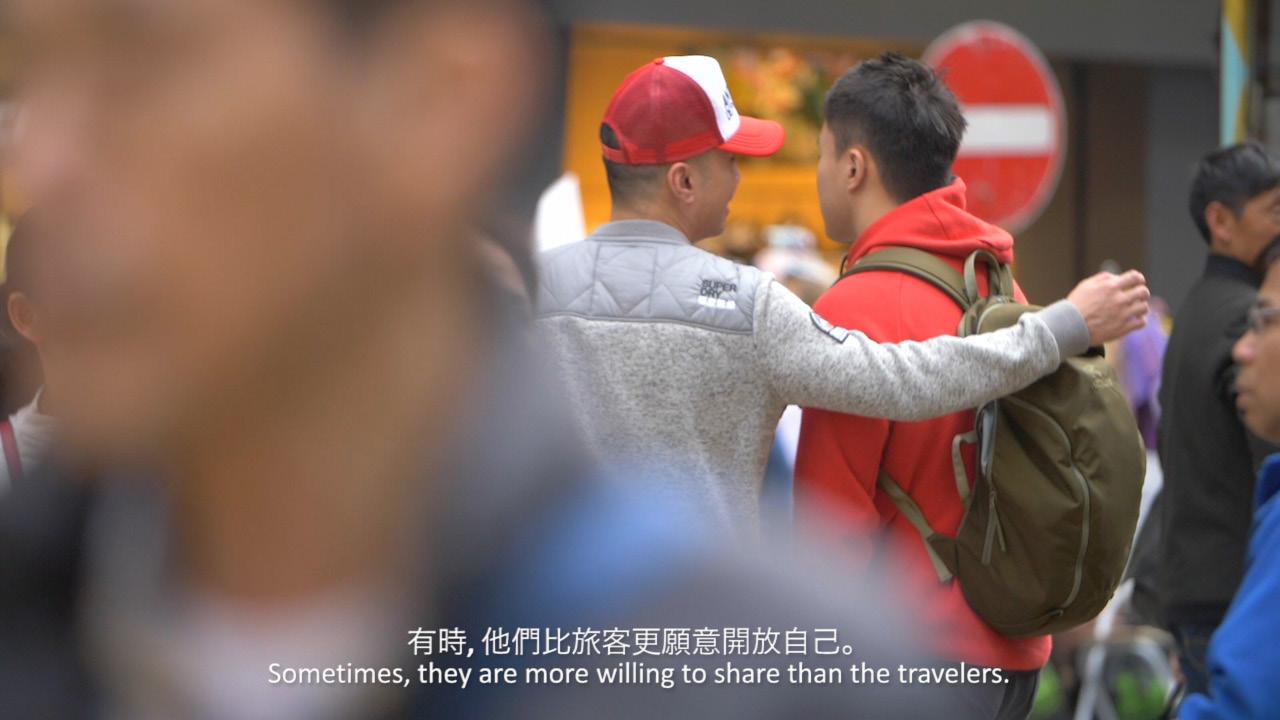
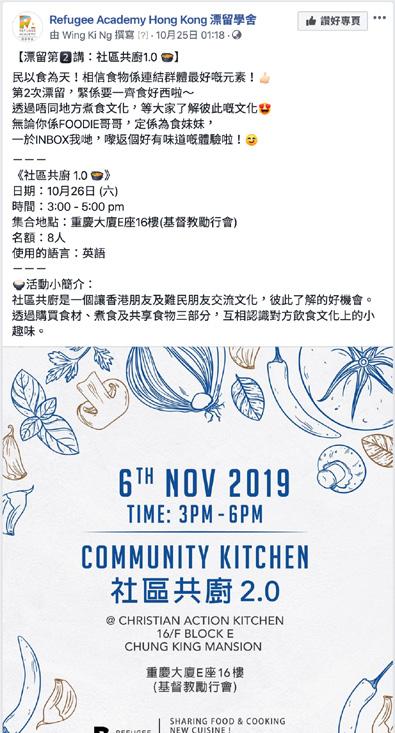
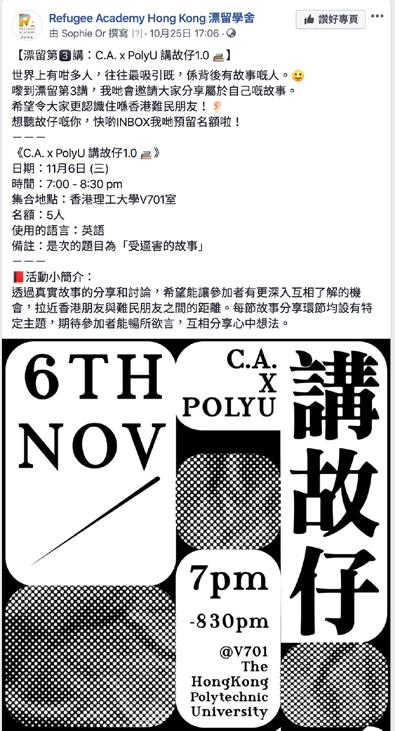
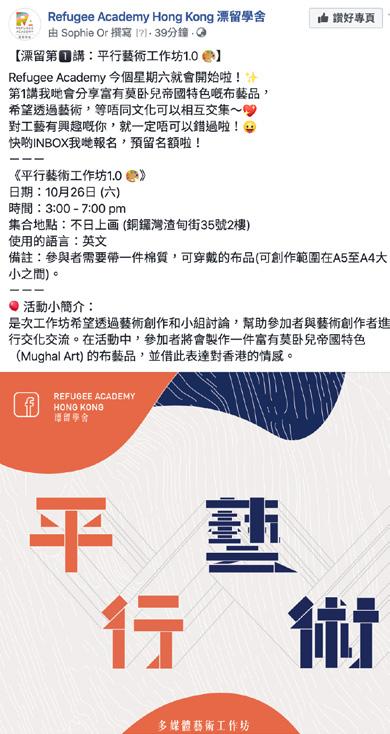

dots. 160 161 2.30 2.30 2.30
Introduction to RA RA Highlight . Promoting RA . 04 Sustainability 4.3 Communication Outreach
Below-the-line (BTL) communication
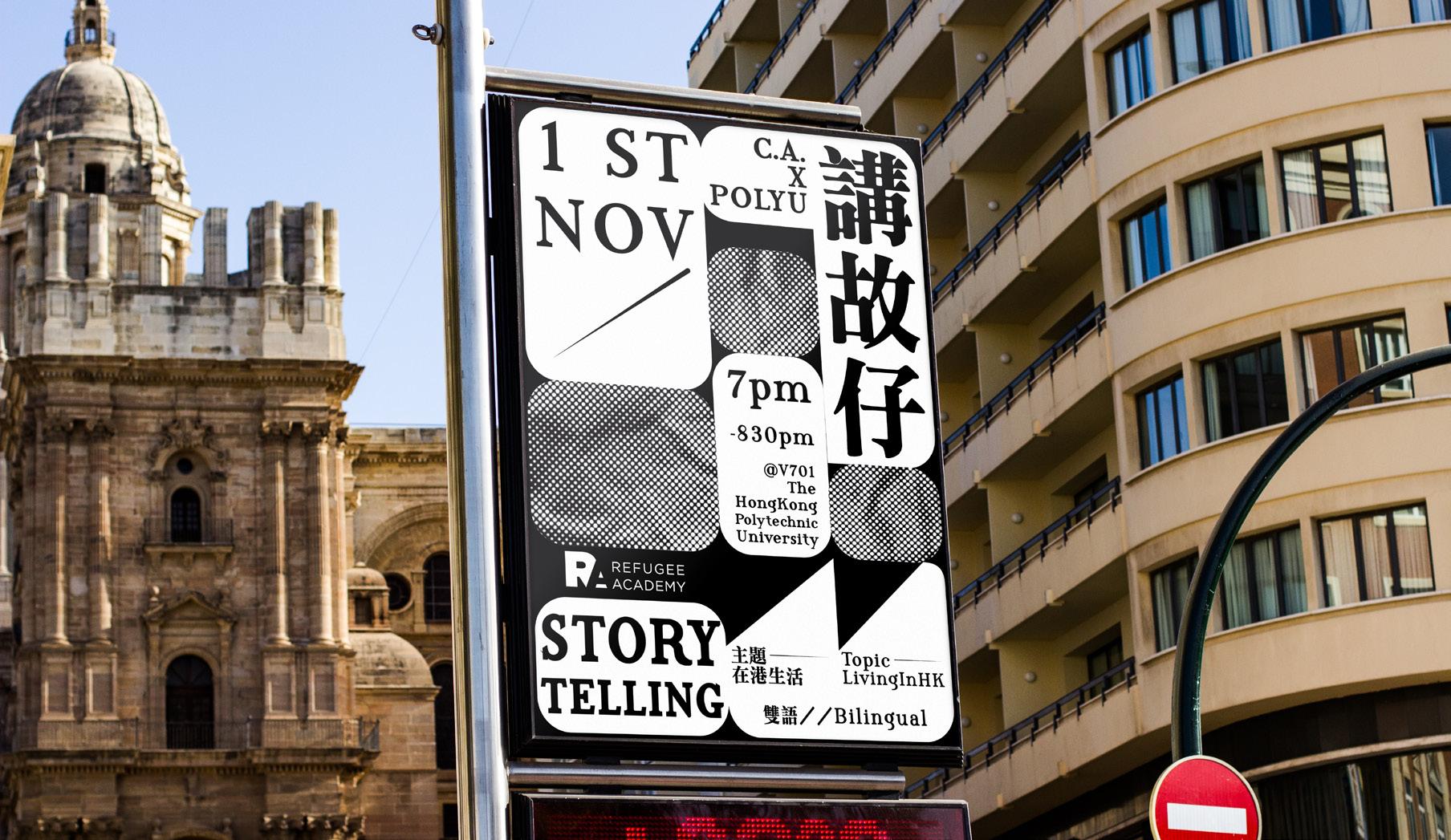
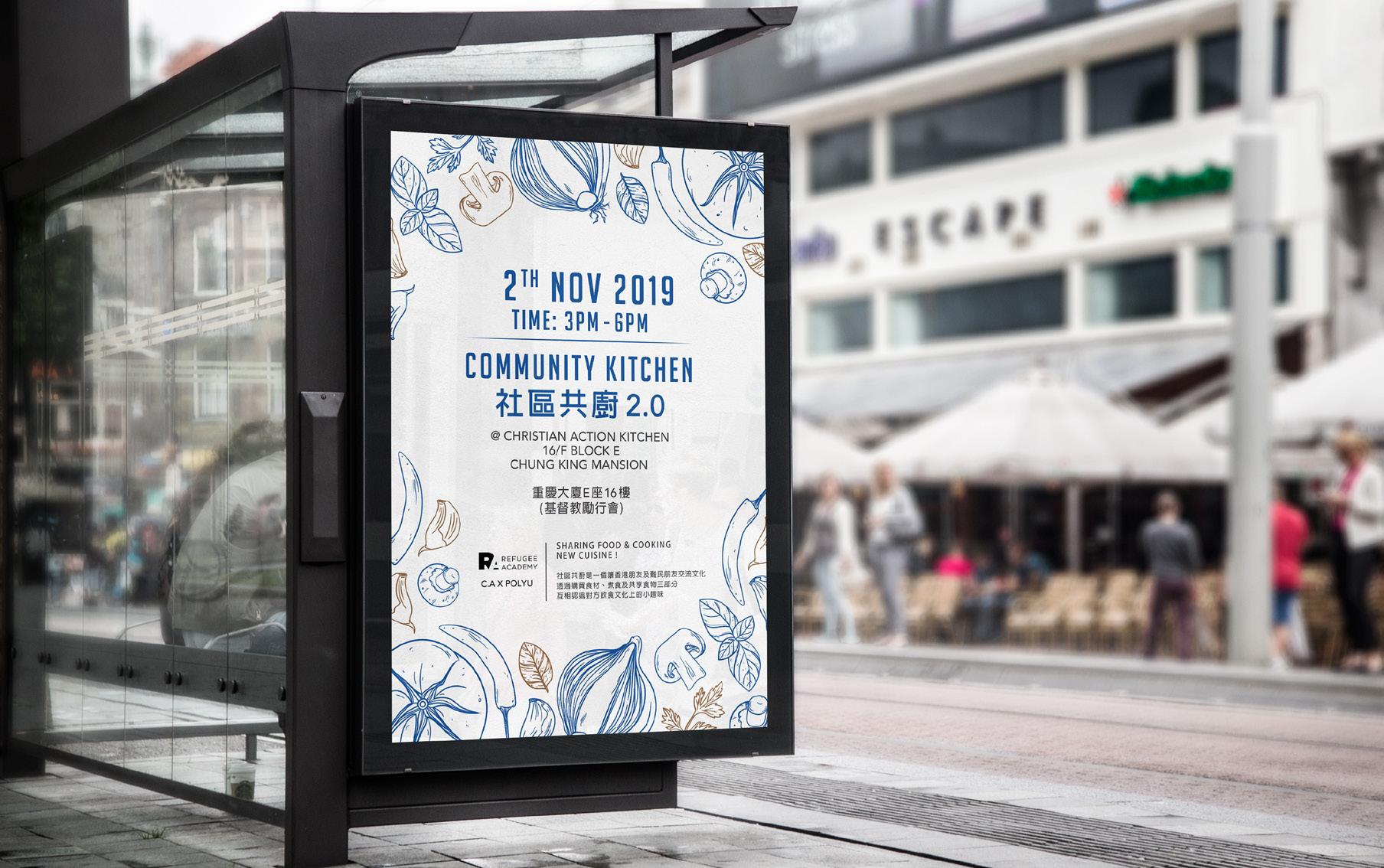
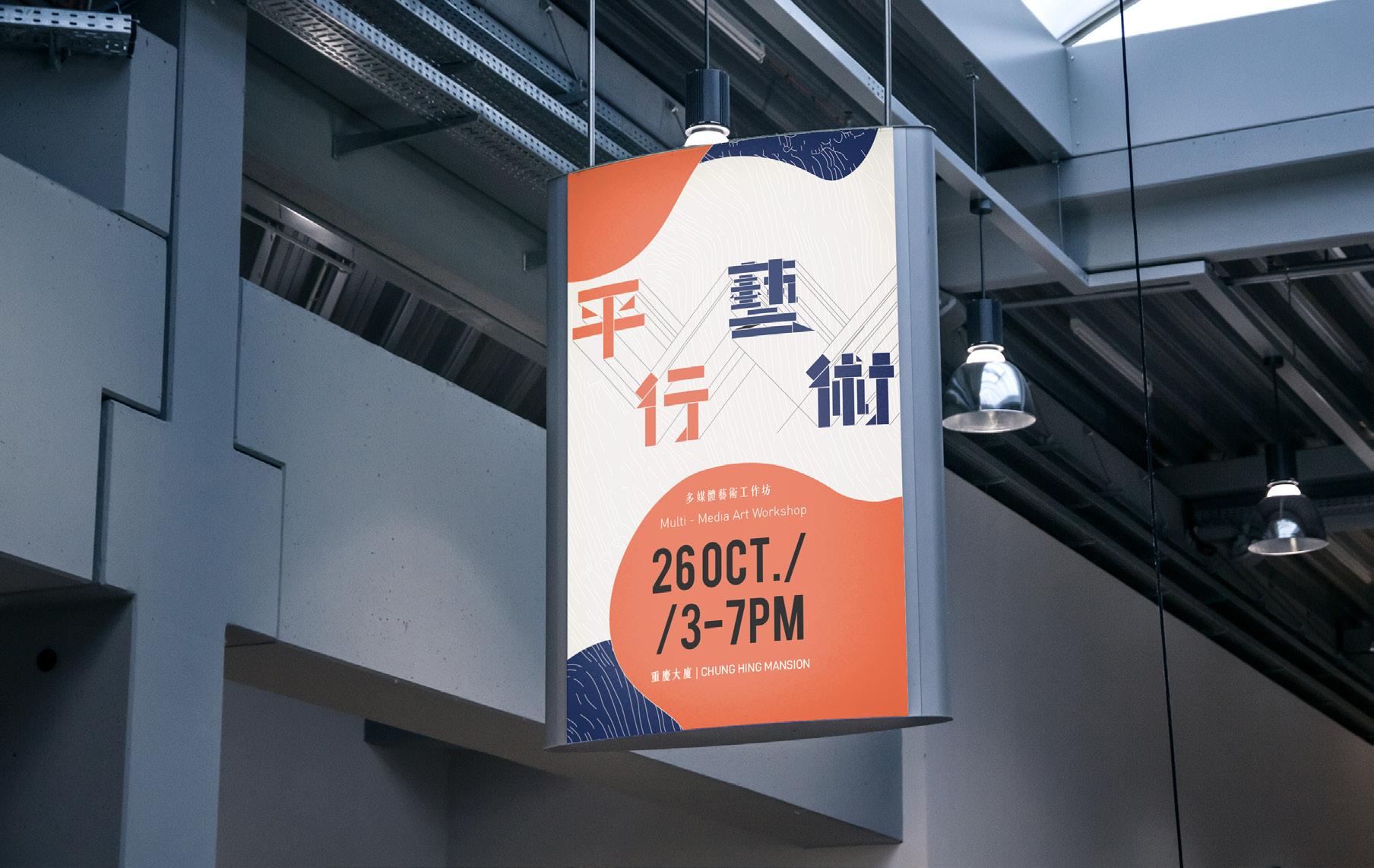
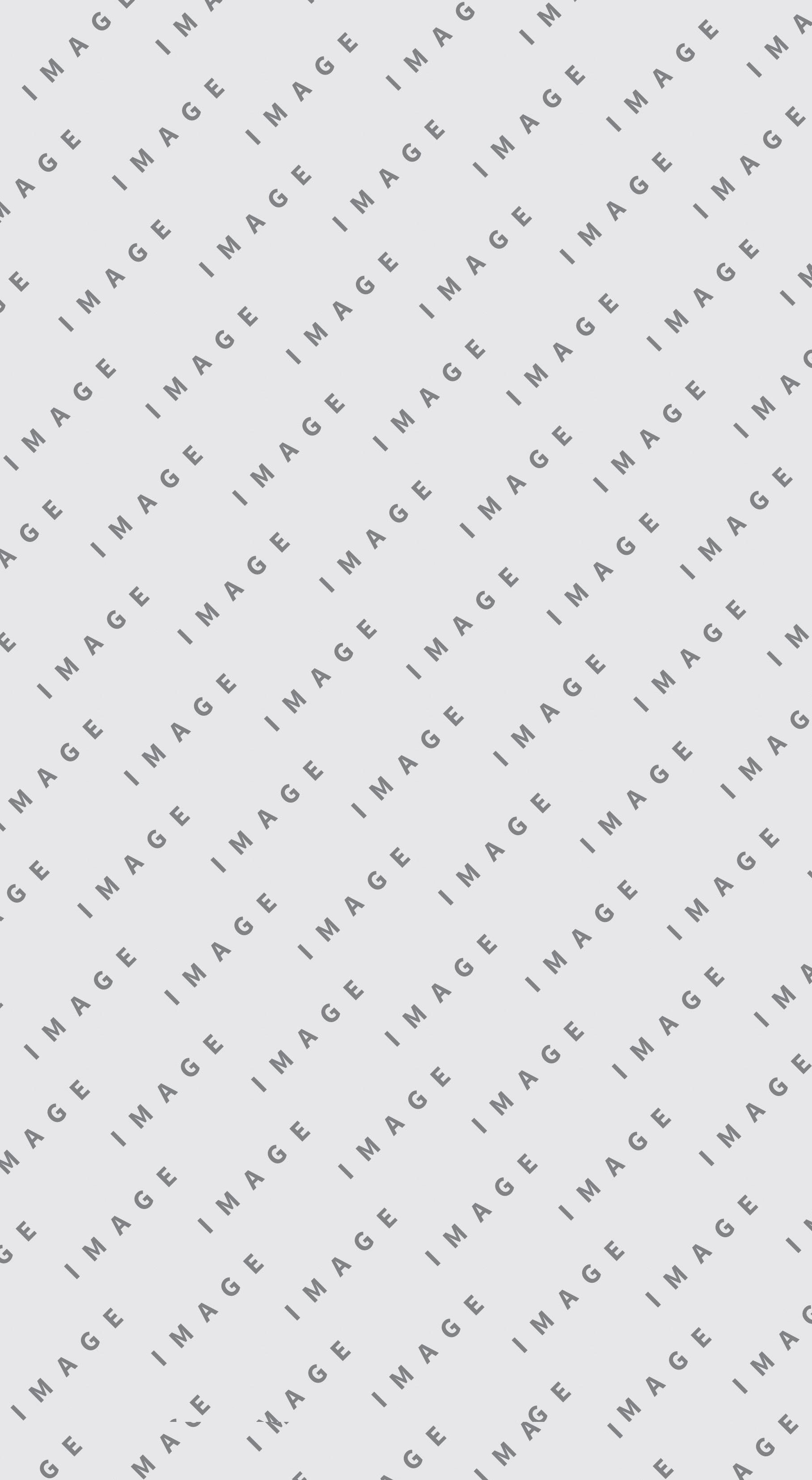


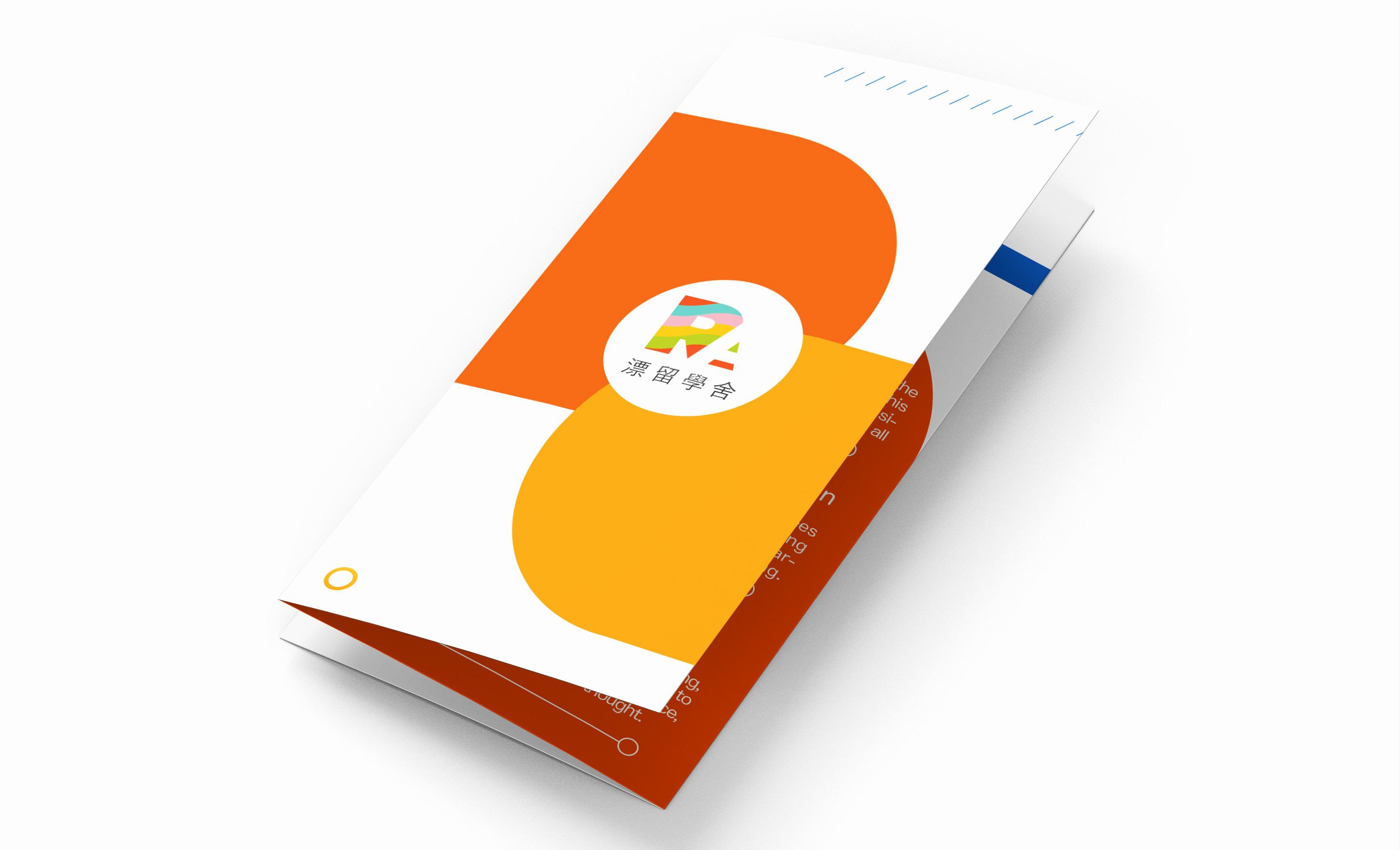
163
dots.
4.4 Future imagination Local networks can be built

Refugee Academy is a sharing platform for connecting refugees and locals. By holding different multi-formed scenario activities, RA hopes both parties can build a strong relationship not just in the "class", but also in their daily life. Providing chances for both parties to get to know each other, RA is willing to link up various local stakeholders as well, for example, venue provider, resources provider, small companies and even enterprises. A diverse community is not just for multinational people, but also for people from different social hierarchies.
More challenges are coming
Community projects are not new in Hong Kong, but it seems difficult to maintain and sustain. Being the first project that getting refugees involved, Refugee Academy will be facing lots of challenges. Because of the unstable political environment of Hong Kong society, refugees are becoming more sensitive. Safety issues are also being concerned. Fortunately, RA will happen after the Chung King Mansion Tour in Oct 2019, which was a great step for the inclusive community of Hong Kong. How RA will be in the future? It is really unpredictable. But still, we cannot predict, but take action for a better local-refugee community.
165
04 Sustainability
4.4 Future Imagination
Bibliography
Bibliography
Choi, C. (2014). Calls for more transparency as food costs for Hong Kong's asylum seekers don’t add up. Retrieved 23 September 2019, from https://scmp.com/news/hong-kong/article/1430939/ calls-more-transparency-food-costs-hong-kongs-asylum-seekers-dont-add
Choi, C. (2014). Protesting asylum seekers say food provisions ‘not worth’ what government contractor claims. Retrieved 12 September 2019, from https://scmp.com/news/hongkong/article/1426463/protest-asylum-seekers-food-provisions-not-worth-ISS-HK
Christian Action. (2014). ChungKing mansions service centre serving refugees and asylum seekers in Hong Kong. Retrieved 18 September 2019, from http://www.law.hku.hk/hrportal/ wp-content/uploads/file/Alison-Mackay.pdf
Immigration Department (2016). Making a Claim for Non-refoulement Protection in Hong Kong. Retrieved from https://www.immd.gov.hk/eng/useful_information/non-refoulement-makingclaim.html
LegCo Panel on Welfare Services. (2019). Ways to improve situation of refugees, torture claimants and asylum seekers in Hong Kong. Retrieved 21 September 2019, from https://www.legco.gov. hk/yr12-13/english/panels/ws/papers/ws0722cb2-1630-3-e.pdf
LegCo Panel on Welfare Services (22-07-13) Written Submission Malabika Das, MSW, PhD Candidate, University of Hong Kong. (2013). LegCo Panel on Welfare Services (22-07-13)
Written Submission Malabika Das, MSW, PhD Candidate Department of Social Work and Social Administration The University of Hong Kong. Retrieved 23 September 2019, from https://www. legco.gov.hk/yr12-13/english/panels/ws/papers/ws0722cb2-1805-1-e.pdf
South China Morning Post. (2016). Are asylum seekers crossing the line? Retrieved 21 September 2019, from https://multimedia.scmp.com/chungking-mansions/chapter3.html
United Nations High Commissioner for Refugees Hong Kong (2019). Refugee Q&A. Retrieved from https://www.unhcr.org/hk/en/about-us/faq-of-refugees
Vecchio, F., & Beatson, C. (2014). Occupy ISS: Why did it happen and why should we care? Hong Kong: VF Research Insight Series.
盧君朗(2018年9月9日)。難民審批時間長 不許工作難以生活 難民關注組織:望開放工作權。香港 01。檢自:http://bit.ly/2pI9HtW
流浪之聲 (2018年1月30日)。【難民101】在香港,如果你是一個「難民」: 99.6%的機率,你會難以 留下亦無法離去。換日線。檢自:https://crossing.cw.com.tw/blogTopic.action?id=824&nid=9367 梁梓澄(2017)。「我不是假難民,更不是罪犯!」—初談香港免遣返聲請(non-refoulment claims)的審查機制。檢自:http://bit.ly/2qCc9Cu
滯港11年,難民聯會主席︰「我們已沒有未來了,所以要為孩子的未來著想」(2016年6月20日)。 關鍵評論網。檢自:https://www.thenewslens.com/article/42375
李雁齊(2014年3月22日)。難民佔領逾月抗議ISS貪污 社署無視 拒絕商討。獨立媒體。檢自:http:// www.inmediahk.net/node/1021726a
鏗鏘集(2016年3月20日)。難民真與假。香港電台。檢自:https://www.youtube.com/ watch?v=zlHOHPfOfjo
167 166 dots.
05 Bibliography
1. Survey data
2. References of related bottom-up school
3. Case references
6 Appendix
dots. 169 From dots to a circle Chapter 6 : Appendix 0
Appendix
Q1. Do you have cognition of refugee?
1. Survey Data Result Data
Q2. Is there any refugee in hong kong?
Q3. Do you know the reasons of becoming refugee?
dots. 171 170 06 Appendix Appendix : Survey Data
perception towards the refugees in Hong Kong Type Online Survey No. of Questions 17 Respondents 113
Local's
38.1% 61.9% Yes No
5.8% 7.1% 87.1% Yes I donÕt know No
8.6% 91.4% Yes No
Q4. What are the reasons of becoming refugee?
Q6. What is your impressions of refugee?
Q5. Which channels do you obtain the refugee news?
CanÕt settle down in any countries
They strive to survive
Being persecuted for his own countries
Just
dots. 173 172 06 Appendix
Internet News and magazine School
welfare agencies
description
in church
Books
with
in UNHCR Television Academic essay Overseas trip Work
Social
Friends
Friends
Directly interact
Chatting
refugee Working
Natural disaster National subjugation Connected with hong kong relatives Political persecution Religious persecution Race persecution Covet with the HK welfare Grave crime in his own country Having more job opportunities in hong kong Father and mother are also refugee Own country is chronic poverty War 0 60 40 20 0 30 20 10 40 50
at English
dark skin
education background
sports
donÕt
things
Theft Good
With
Low
Underprivileged Kind, optimistic and cheerful Terrorist or social extremist Good at
Lazy I
know Stealing
Poor Exhausting Persecution
Lack of basic requirements of life
Political persecution Wretched
Persecution Hard-working
Sad
0 80 60 40 20
Like normal people
CanÕt earn money in hong kong
Appendix : Survey Data
Q7. Which situation do you think it belonged to refugee real- life?
Q9. If you find other interesting refugees' topic, please write it down
Will refugees become Hong Kongers?
How refugees integrate in Hong Kong society?
Why refugee choose Hong Kong?
The background of refugees
How refugees deal with the identity issue?
How refugees feel about their hometown?
How can we help the refugees in hong Kong
What difficulties refugees are facing?
The edcation issue of the refugee children
Any occassion that we can help them.
Q10. Which of the following will be the reasons for you taking the initiative to get to know the refugees? (Can select more than one answers)
Q8. Are the following topics interesting to you?
The difference between refugees and asylum seekers
Stories and reasons of becoming refugee
Ideal life of refugee
Political views of refugees
News reports
Cultural exchange
Meet new friends
Avoid misunderstanding
Social welfare group propaganda
The people around are refugees
Worried about becoming a refugee
Watched movies about refugees
Don't want to know refugees
Aviod misunderstanding
Very interested interested
Uninterested Very uninterested
dots. 175 174 06 Appendix
A B C D E
Culture, family background and language of refugee
The daily life in Hong Kong of refugees
Refugees' views on Hong Kong
0 60 40 20 80 100 0 60 40 20 80 100 120
0 30 20 10 40 50 60 Appendix : Survey Data
Q11. Are the following cultural exchange activities interesting to you?
Participate in volunteer service
Friend introduction
Watch movies about refugees
Cook with refugees
Refugees' life experience day
Refugee discussion group
Play board games with refugees
Do sports with refugees
Uninterested Very uninterested Very interested interested
Q12. Are you interested in learning a new language?
Very interested interested
Uninterested
Very uninterested
Q13. Are you interested in learning the following languages? (Can select more than one answers)
Q14. Are you interested in learning new language with refugees?
Very interested interested
Uninterested
Very uninterested
dots. 177 176 06 Appendix
16.8% 62.8%
20.4%
0 60 40 20 80 100 120 Arabic Udu/Urdu Afrikaans Dali Persian Spanish Not interested in learning new language Afrikaans (Not African Common Language)
0 30 20 10 40 50 60 70 80 9.7% 1.8% 30.1% 58.4%
Survey Data
Appendix :
Q15. Can you skillfully communicate in the following languages?
What is your gender?
Q16. Will you join refugee cultural exchange activities hosted in the future?
What is your age group?
Q17. If you are interested in refugee cultural exchanges and would like us to share further information, please leave a contact number or email address:
What is your education level?
Primary or below
Secondary
Associate degree/ Bachelor's degree
Master's degree
Doctoral degree or above
dots. 179 178 06 Appendix English Cantonese Skilled Unfamiliar Very skilled
24.9% 13.2% 61.9% 3.6% 15% 81.4% 53.1% 11.5% 35.4% No Will consider Yes
32.7% 67.3% Female Male
9.7% 4.4% 17.7% 63.7% 3.5% 0.9%
below
between 31 to 36 years old 37 years old or above between 19 to 24 years old between 25 to 30 years old
12 years old between 13 to 18 years old
0.9% 5.3% 85.8% 8% Appendix : Survey Data
Appendix
school
Related bottom-up community informal school of knowledge
Bristol, UK
https://www.ulk.org.uk/
Fugees Academy (grades 6-12), Atlanta, Georgia https://www.fugeesfamily.org/educationfugees-academy
Refugee Academy, Amsterdam https://fsw.vu.nl/en/research/expertise-labs/expertise-lab-refugee-academy/index.aspx
Refugee Academy, Berlin
https://refugeeacademy.de/home/en/home-english
Refugee Code Academy (Phoenix, Arizona) http://refugeecodeacademy.org/
TERN (The Entrepreneurial Refugee Network), London http://www.wearetern.org/
Virtual University of Uganda, Uganda https://virtualuni.ac.ug/the-virtual-university-of-uganda-launches-the-special-academy-toenable-learning-for-the-refugee-community/
WtOS, New York State
dots. 180 06 Appendix Are you a permanent resident of Hong Kong? 99.1% 0.9% Yes No Do you know your community? 30.1% 69.1% Yes No
https://otda.ny.gov/programs/bria/wtos.asp : Related bottom-up
2. References
3.Case References
The Korable Block
The Korable Block by Si-Yeon Min Teaches People to Speak Korean
Sarah Nazim — August 21, 2012 — Art & Design
The Korable Block by Si-Yeon Min is a fun and interactive game that teaches anyone to speak Korean. Each block contains alphabet characters that can be combined to create over 120 single-syllable words.

Si-Yeon Min is a New-York based designer and architect who had initially created the toy for his son, but due to the simplicity and creativity of the blocks, started to gain international attention.
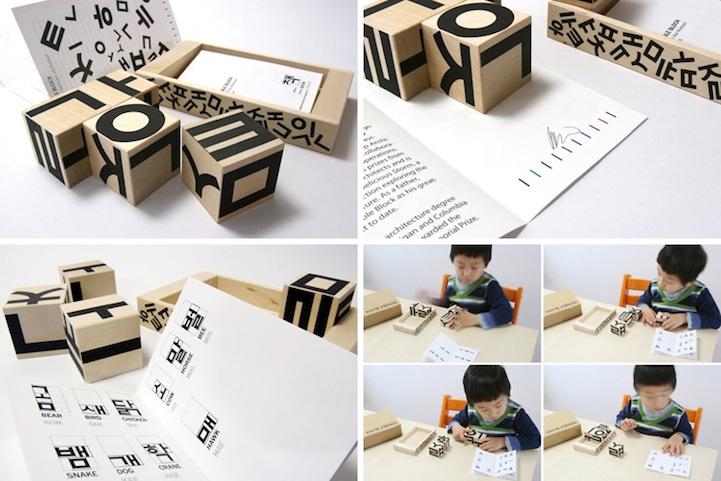
Children often have short attention spans, and having to teach them a new language isn't always easy, which is why the Korable Block is a great alternative to traditional teaching methods. Min makes a great point by stating on the site, “Among the toys and games designed by architects, a few stand out—Rubik's cube, Sudoku, and the Korable Block.” Min has created a distinctive product that is sure to be around for generations to come.
'DipDip' is a Plush Panda Capable of Teaching Nine Different Languages
Katherine Pendrill — June 2, 2015 — Tech
'DipDip' is the world's first multilingual teaching toy designed to help children learn new languages with ease and confidence. The adorable plush panda uses fun interactive games to help make learning languages less tedious and challenging for children, as well as their parents.
By harnessing the power of the right brain, DipDip uses a unique gaming system and an accompanying app to communicate with the user. All a child has to do is press a button and DipDip will begin sharing an immersive story in multiple languages. By speaking, playing and listening to the panda story, children can gradually improve their language skills and progress through various levels of difficulty.

Children can use the toy independently or with a parent for a shared family learning experience. The multilingual teaching toy contains the audio of professional native speakers in nine different languages, including English, French, Spanish, German, Italian, Korean, Japanese, Chinese and Cantonese.
Official website: https://www.dipdip.com/
dots. 183 182
Appendix : Case References
DipDip 06 Appendix
Jamma Jango
Strawbees Design & Construction Kit
OUR GAMES TO LEARN CHINESE ARE TESTED FOR EFFECTIVENESS AND FUN
• By ordering the introductory Mandarin Chinese kit with the digital download, your child can immediately start using their new language learning program.
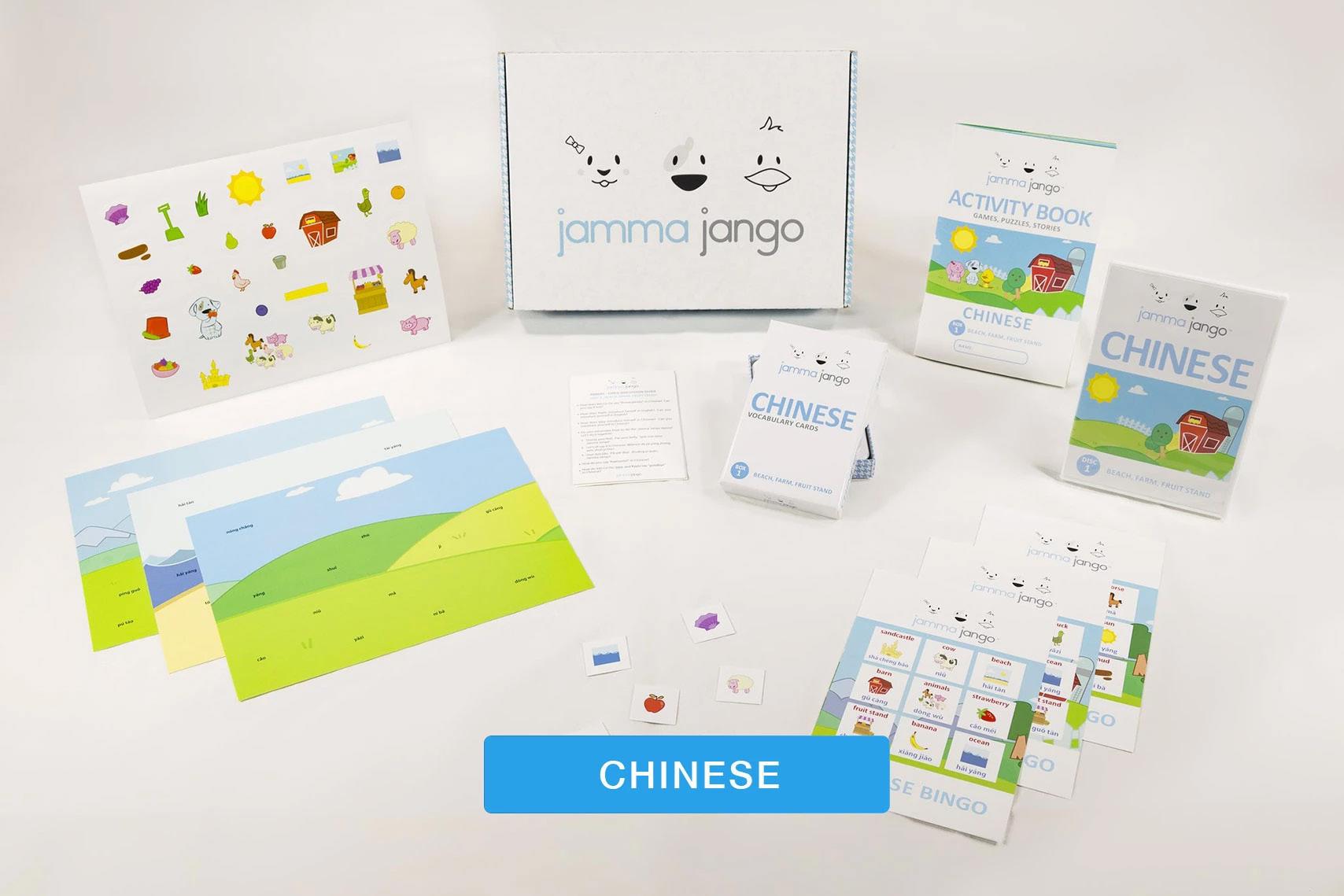
• Complement your child’s Chinese preschool or incorporate Chinese for babies into their daily routine for fast results.
• Games to learn Chinese are proven to be more effective because they hold attention longer and make learning fun.
Here at Jamma Jango, we’re committed to language learning programs that will truly make a difference in your child’s life. By using our games to learn Chinese, your child will learn Mandarin, set a strong foundation for continuing to study languages, and become a lifelong learner. This introductory kit includes Chinese language videos, flashcards, and more, and it’s ideal for children aged 0 to 7.
Strawbees Design & Construction Kit

Kids want to create huge things. With the School kit, a lot of kids can build huge at the same time. Perfect for schools, maker spaces and science centers.
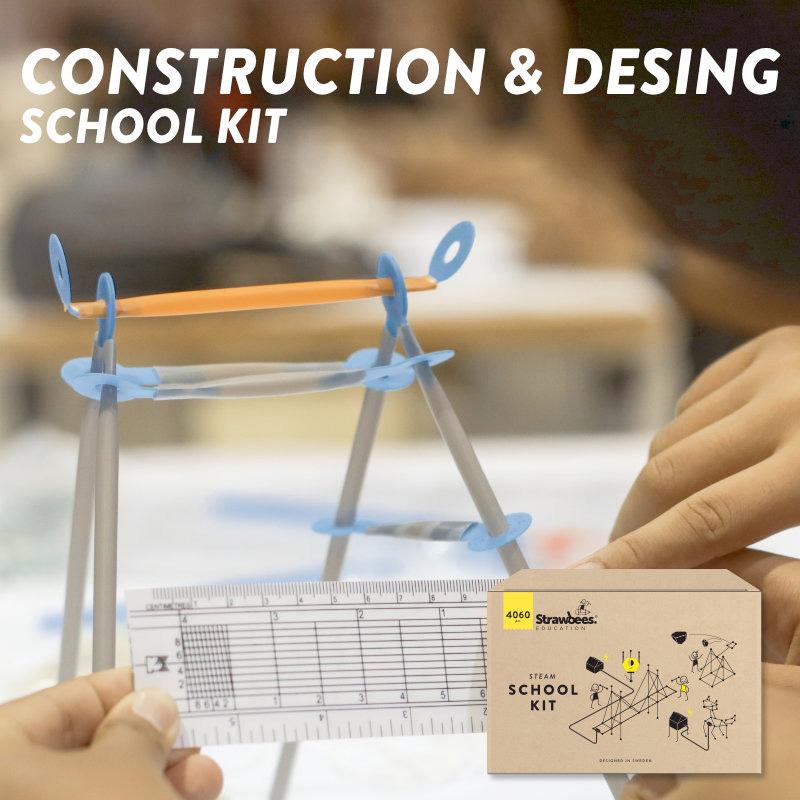
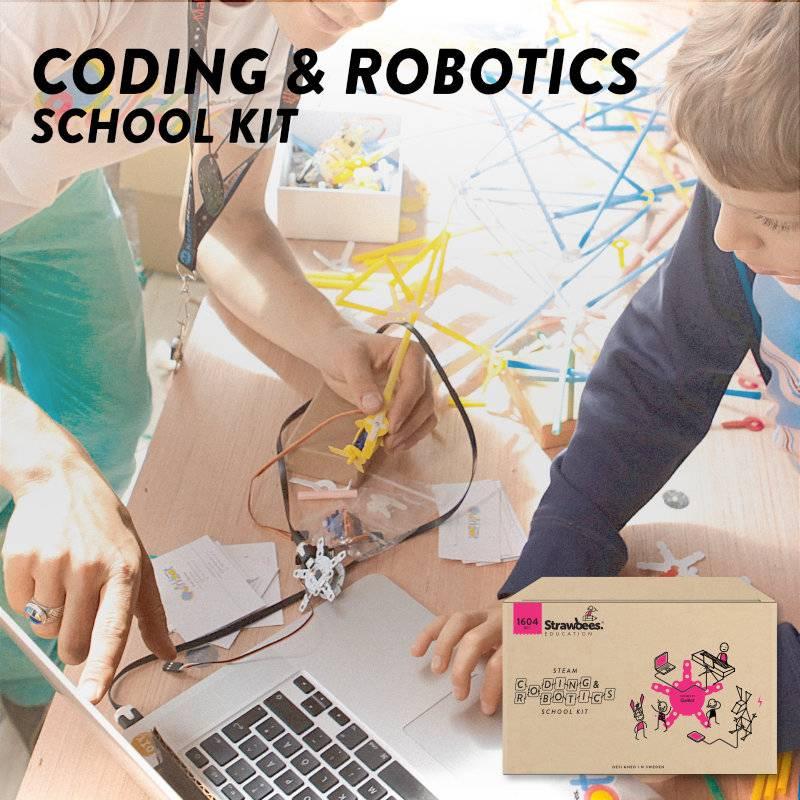
The Kit includes:
• 2560 Strawbees (connectors)
• 1500 Construction Straws (in 6 wonderful colors)
• 1x Pocketful of Ideas Card Deck
Immerse your classroom in project-based learning exercises with bridge building challenges, constructing tetrahedral kites, the egg drop, and much more!
dots. 185 184 06 Appendix Appendix : Case References
Urban Furniture CPD Civic Design
Design & make open source urban furniture for public spaces https://community.oscedays.org/t/challenge-design-make-open-source-urban-furniture-for-public-spaces/318
This collaboration was born at the ECF Idea Camp ‘14 1, bringing together activists & practitioners from across Europe who were reshaping public space. Initially three distinct projects below, we networked together to create Public Space Makers. Hack (y)our Borders 5 helps discover the social and cultural barriers that people face when using public spaces.
Urban Furniture for Sharing 10 seeks to promote participatory urban culture and revitalise deactivated public spaces, our interdisciplinary team develops urban furniture, which is designed for sharing
Open Source Public Space Devices 12 is a potential kit of resources and knowledge shared by communities and urban practitioners already involved in shaping and redesigning public spaces. We want to understand how you can reinvent practices, devices and environments that enable people to feel like they can connect, create and collaborate in urban spaces.
We are doing this by carrying out research with neighborhoods and communities in public spaces, designing and making physical objects and collecting, developing and sharing the methods.


CPD Civic Design
https://www.ucl.ac.uk/bartlett/planning/programmes/cpd-civic-design
This is a blended course for planners, urban designers and architects working in practice, consultancy, as freelancers, or in local authorities. The course is ideal for those involved in codesign processes and community engagement.
Civic engagement is now considered to be a key process in urban design and planning practice. For avoiding ‘box-ticking’ engagement processes that do not genuinely involve communities in decision making, it is essential to learn and experience how to work in collaboration with communities.
Delivered in collaboration with community groups across London, the UCL Civic Design course will:
1) Equip participants with methods and tools to run co-design processes, enable civic engagement and involve communities in decision-making.
2) Expose participants to the direct experience of working in collaboration with community groups.
During the course you will undertake a group project together with a London community group. The brief for the course will be previously agreed with the community groups and it will address some of the current needs of the community. The project is guided by tutors from the Bartlett School of Planning, UCL and offers you the opportunity to learn through direct experience of including communities in the decision-making process.
dots. 187 186 06 Appendix
: Case References
Appendix
CPD Civic Design Refugee camp design project
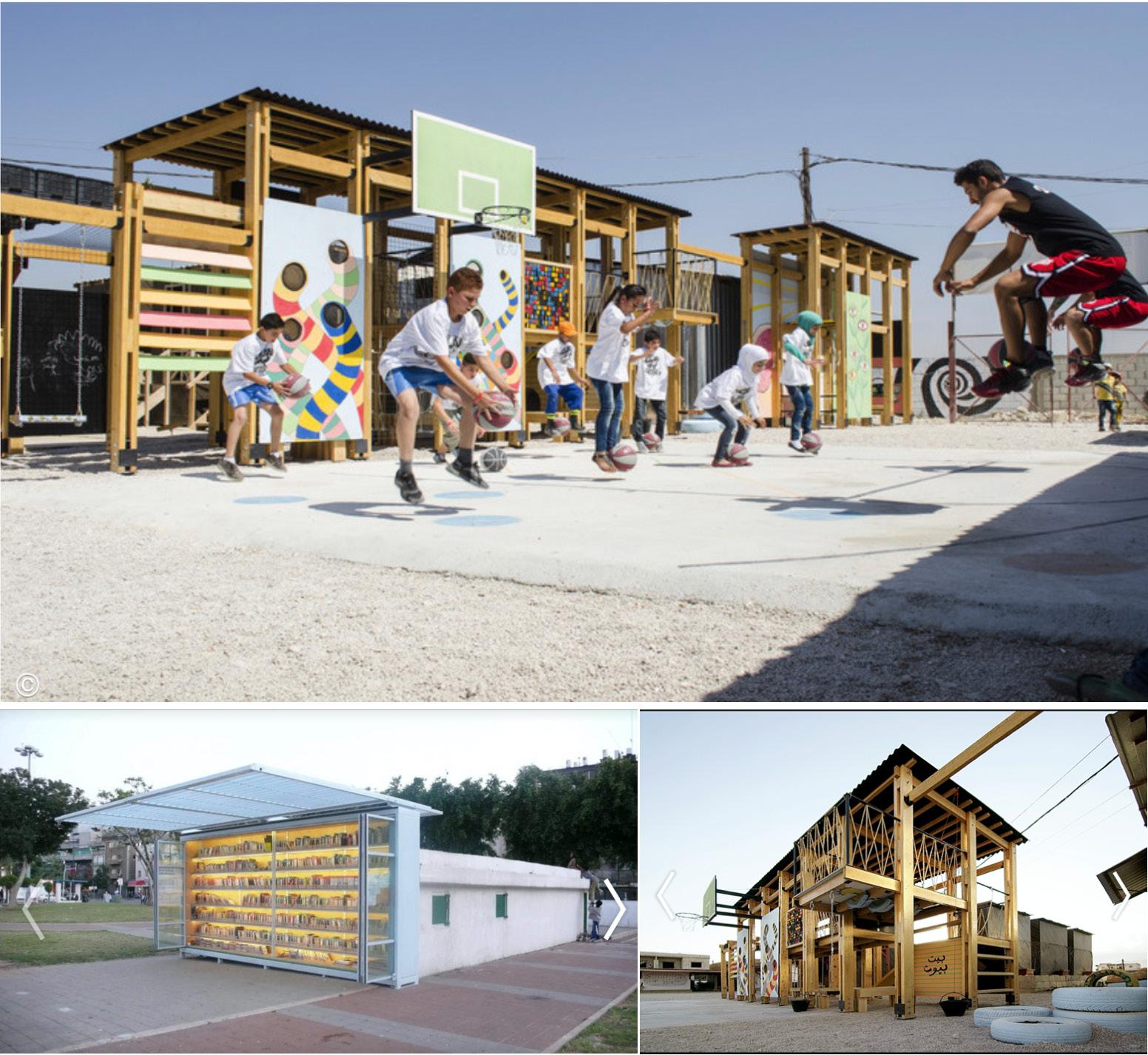
Throughout human history, the movement of populations–in search of food, shelter, or better economic opportunities–has been the norm rather than the exception. Today, however, the world is witnessing unprecedented levels of displacement. The United Nations reports that 68.5 million people are currently displaced from their homes; this includes nearly 25.4 million refugees, over half of whom are under the age of eighteen. With conflicts raging on in countries like Syria and Myanmar, and climate change set to lead to increased sea levels and crop failures, the crisis is increasingly being recognised as one of the foundational challenges of the twentyfirst century.
While emergency housing has dominated the discourse surrounding displacement in the architecture industry, it is critical for architects and planners to study and respond to the sociocultural ramifications of population movements. How do we build cities that are adaptive to the holistic needs of fluid populations? How do we ensure that our communities absorb refugees and migrants into their local social fabric?
Austin Design Week 2018: Talking and gawking
Learn how to run a co-design process, better enable civic engagement and involve communities in decision-making.
https://austin.curbed.com/2018/11/5/18065998/austin-design-week-2018-event-schedule-when- where-free
Now in its third year, Austin Design Week continues to build on its success with a larger and more diverse schedule of events than ever. The interdisciplinary exploration and celebration of designs and designers of all kinds—from architects to graphic designers to urban planners to filmmakers and more—and will include 100 free workshops, studio tours, and events.
This year’s weeklong event kicked off Monday. Its theme, “Open Doors,” is meant to “open dialogue and facilitate learning opportunities regarding design and its role in the community,” according to the event’s website. Its schedule of events focuses on and offers insight into Austin’s creative community.
We’ll update this story throughout the week, but for now it looks like highlights include the latest collection from Sara Reichardt, who makes furniture out of Lego bricks, and an opportunity to tour a custom-designed home at The Residences at W Austin.

dots. 189 188 06 Appendix Appendix : Case References
Art Woman
Art Women, a group of female asylum seekers who share a passion for arts and crafts. Set up In 2017 by Akonyi, a refugee from the Republic of Congo, former nurse with support from Tegan Smyth, founder of Table of Two Cities, a grass-roots project that unites refugees through food.
“Art Women is about creating a safe environment to help women recover from trauma, to help them heal and rebuild self-esteem – to empower them,” says 30-something Akonyi.
Refugee group: female asylum seekers who share a passion for arts and crafts
Initiative nature: a creative collective, counselling and therapy platform for female refugees. Means: Host cloth-making workshops, Imports unisex, traditional Congolese quality fabric liputa*.
ENGEKI QUEST x HK: 城市雀仔冒險之書
*Coming in bright and bold patterns, such African garments have social meaning and pay tribute to popular figures, sports or awareness days
Engagement:
Design team community investigation> artist’s representation & edit > public engagement through workshop & self-guiding individual walking tour with the use of the end product Created by an artist designer team, the guiding book acts as a pathfinding menu for the public to choose their own individual adventure route in Sham Shui Po, in the quest for its birds and their urban life.Online version URL: https://bit.ly/2XOBubS
Communication & Engagement involved: Self-guiding journey, motivation and interests guaranteed A more in-depth experience of getting to know the world from another perspective Tangible product for future reference & collaboration
Parties involved:
偶然空聳(日本)成立於2019 年,主要成員為藤原力和住吉山実里。團隊過去曾以橫濱和京都 為基地,但近年經常都在旅途上,致力連結被無形之牆分隔的世界。他們的“ENGEKI QUEST” 項目曾在不同城市演出,參加者會獲得一本冒險之書,並按照書中指示,自行在城市中冒 險。orangcosong (Japan) Founded since 2019, “orangcosong” is an art collective with two core artists, Chikara FUJIWARA and Minori SUMIYOSHIYAMA. They have based in Yokohama and Kyoto, but are now always on journeys to connect worlds divided by invisible walls. In their tour project “ENGEKI QUEST”, which has been run in various cities, participants choose their own directions according to the instructions of Adventure Book.
"How a Hong Kong refugee is empowering women with art collective" SCMP 2019.8.19 https://www.scmp.com/magazines/post-magazine/short-reads/article/3023048/how-hong-kong-refugee-empowering-women-art
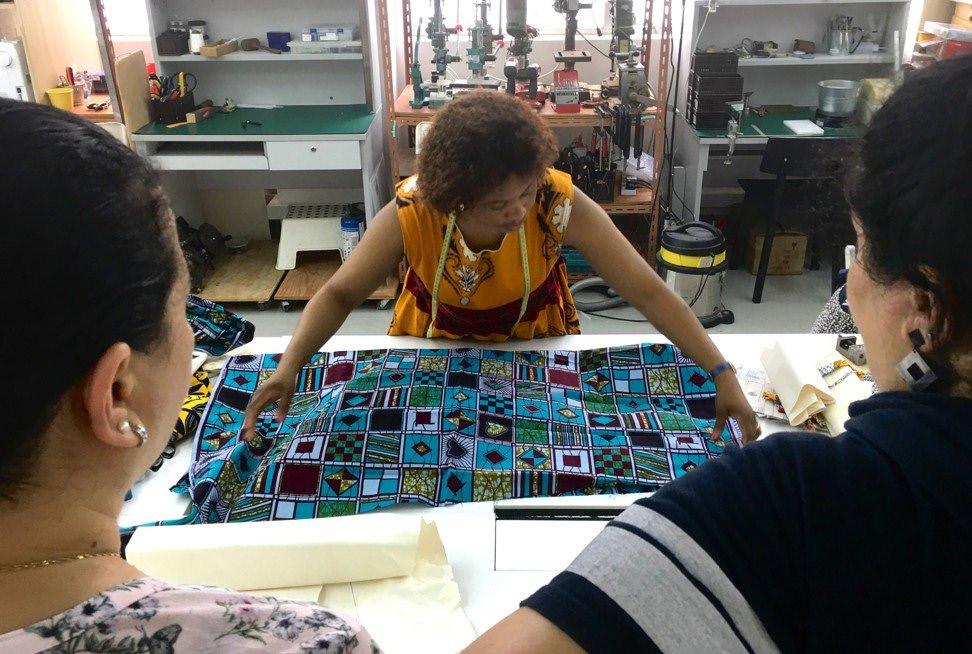
Hong Kong Bird Watching Society
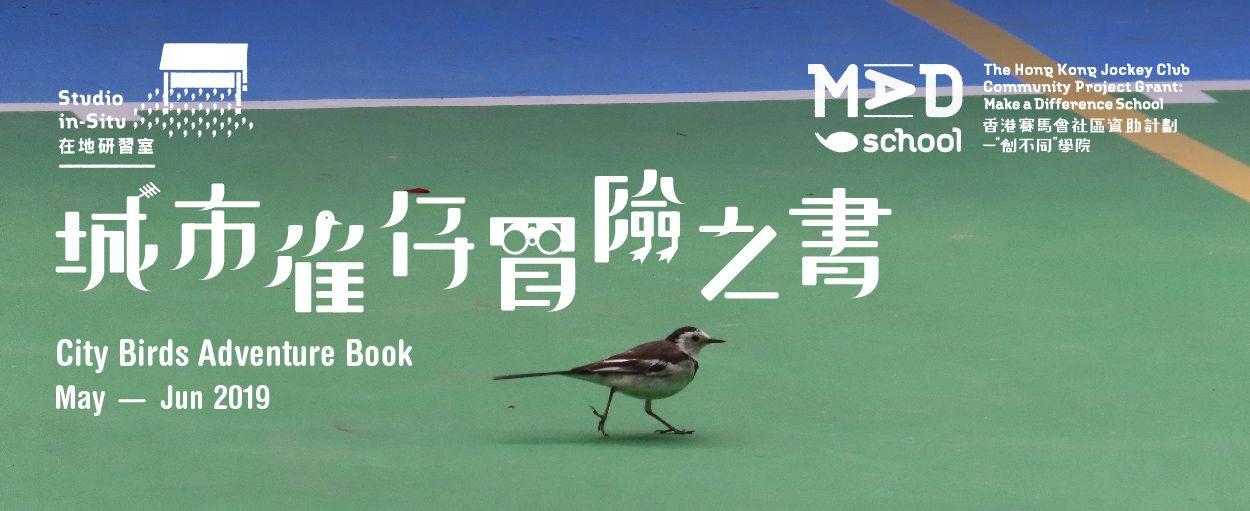
IP Hiu-man, Human An artist and writer, Make A Difference Institute
Programme page: http://www.mad.asia/programmes/mad-school/570
dots. 191 190 06 Appendix
Akonyi at the workshop. Photo: Kylie Knott
Appendix : Case References
Kaifong Tour 街坊帶路
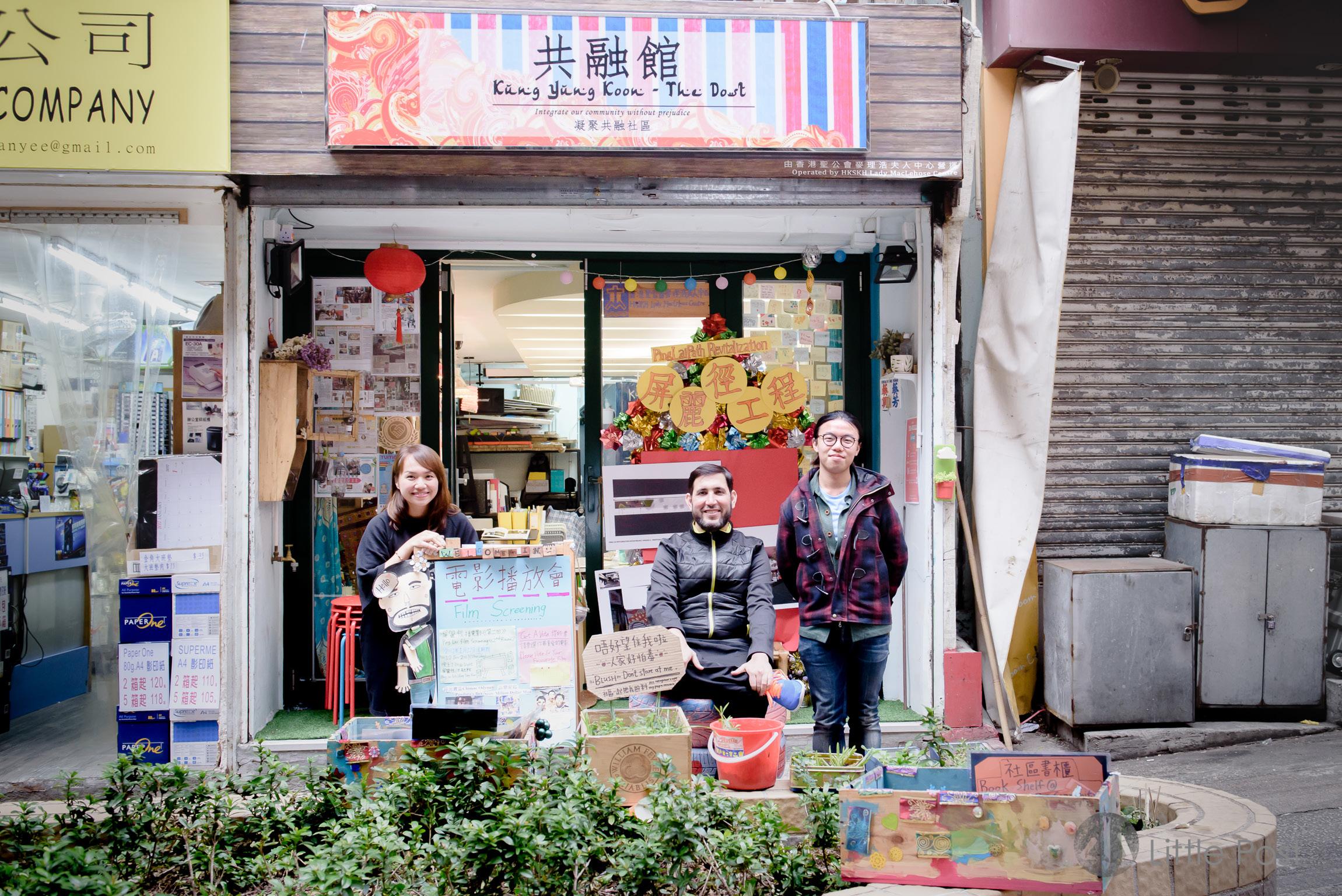
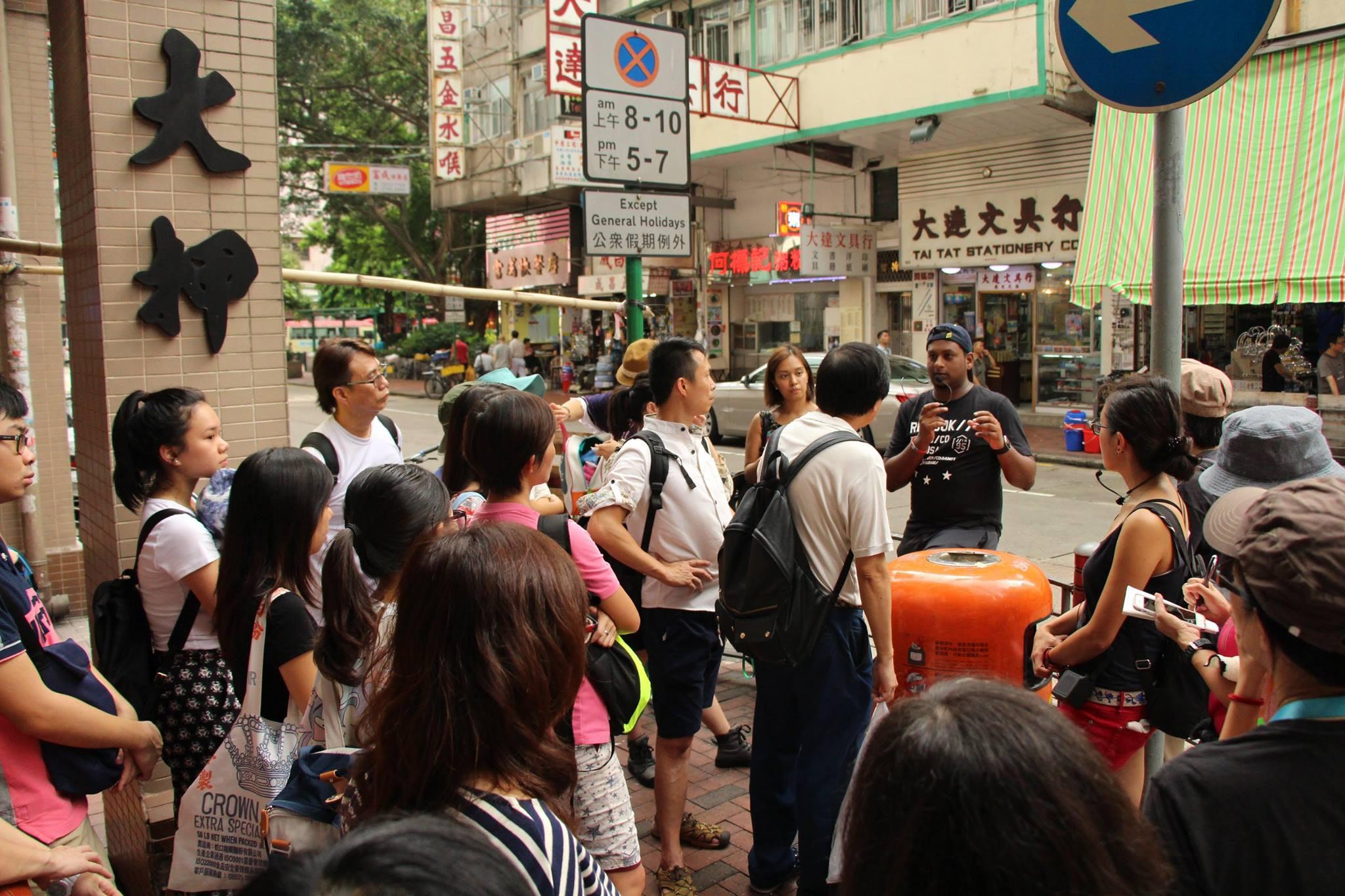
「街坊帶路」是一間專注為各機構提供教學及培訓體驗的香港社會企業。透過社區導賞、培訓 工作坊及其他社區項目,我們以社區作為真實教育及實踐場景,讓當地街坊以導賞員的第一身 角度,帶領老師和學生,仍至來自不同大型機構的工作者互動探索,打開學習想像,讓參加者 細味每一個社區的獨特之處,藉著親身體驗反思不同社會議題。
希望以社區為核心,善用社區資源昇華教育;深化社區、街坊及公眾的連結。
服務包括:
- 社區體驗/考察/導賞 - 社區導賞員培訓
社區探索工作坊
Website : https://www.kaifongtour.hk/

Kung Yung Koon-Shabnam 共融館
共融館,不是咖啡館、麻雀館,也非社區中心;它是2014年由香港聖公會麥理浩夫人中心獲巿 區更新基金資助後,於屏麗徑設立的一個生活館,透過實體空間,讓來自不同種族而又天天碰 面的街坊交流。這些交流,包括展覽、導賞團、工作坊和分享會等。
讓不同種族的朋友於同一天空下,有一個廣闊的交流空間,拉近文化差異,把誤會、偏見都一 一挪開。共融館的最大用處,是能夠打開門,讓不諳中文的少數族裔願意走進來分享生活困 難; 讓本地人與 少數族裔建立關係,慢慢解 開 少數族裔 心中的 困 解 。同樣,因為有了這個地 方,中國人也能有平台了解身邊少數族裔的處境。拉闊 眾人對於社區的想像,讓大家知道自己 居住的地區有這麼多異國文化,社區也可以很好玩。
Website : https://www.facebook.com/ourpinglaipath/
dots. 193 192 06 Appendix
Appendix : Case References
-
A co-design project with the refugees in Hong Kong
Credit to
CHAN Man Ching, MC
CHEUNG Cheuk Nam, Chad
CHOW Yan Lam, Amy
CHOY Lok Yi, Claudia
CHUNG Ka Yan, Fafa
FUNG Kar Hei, Francis
LAM Wincy Wing Se
LAW Long Hei, Lester
LUK Ching Man, Cassandra
NG Wing Ki, Wingki
OR Wai Man, Sophie
TAM Kui Kwong, Desmond
YEE Tsz Ching, Reeta
YIP Sze Wing, Ceci
Special Thanks
CHAN Kam Fai
SIU King Chung, King
POLYTECHNIC UNIVERSITY
2019/20
SCHOOL OF DESIGN COOPERATIVE PROJECT dots.
From dots to a circle : A co-design project with the refugees in Hong Kong











































































